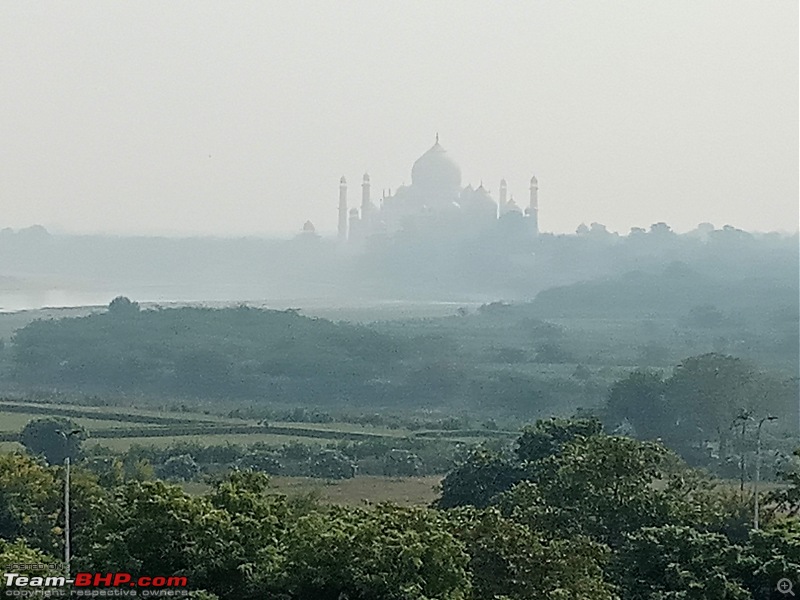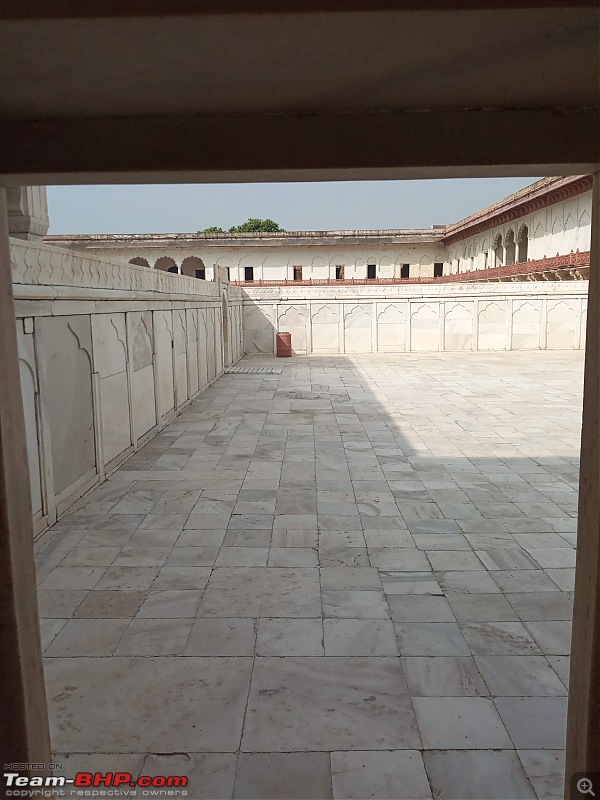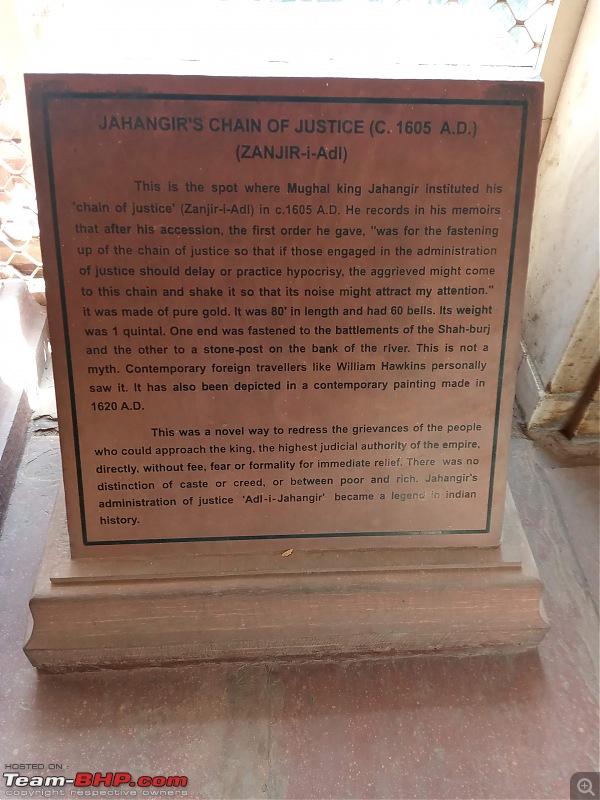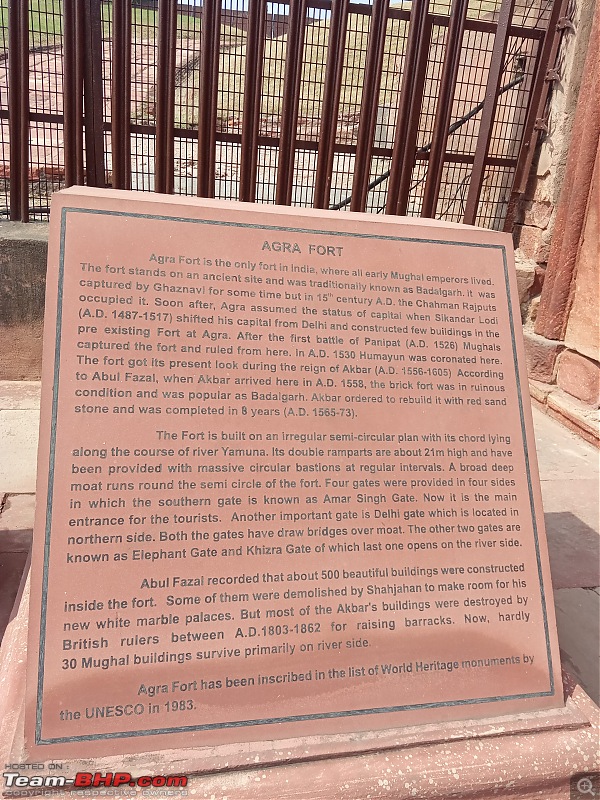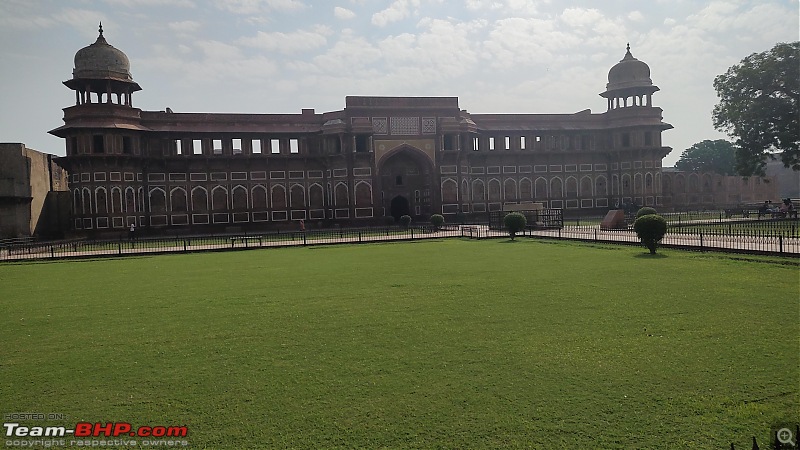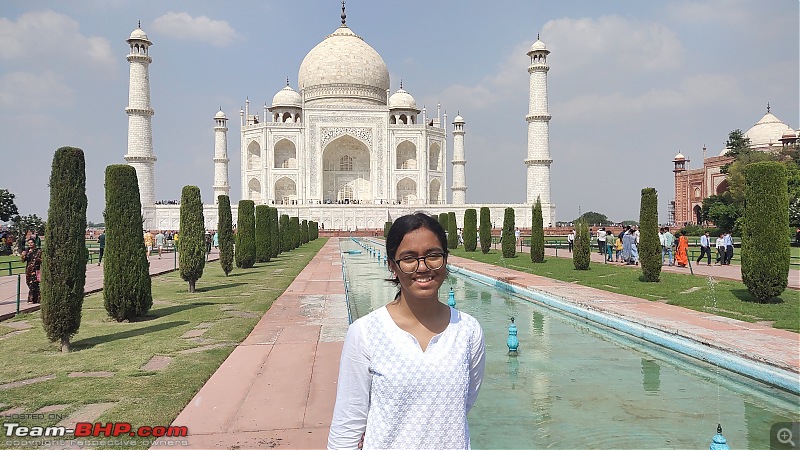Hello everyone! Welcome to this travelogue - of trip which is the longest and most epic we've had! I will try and make this article fun and informative to read. I would love to know what you think. Your thoughts and ideas will help me improve my writing. Hope you like it!
(Note for readers on this blog - I had originally written this travelogue on a forum called Team BHP. If you would like to red it from there, click on this link: From palaces to peaks - Uttar Pradesh & Uttarakhand - Simply heaven! - Team-BHP
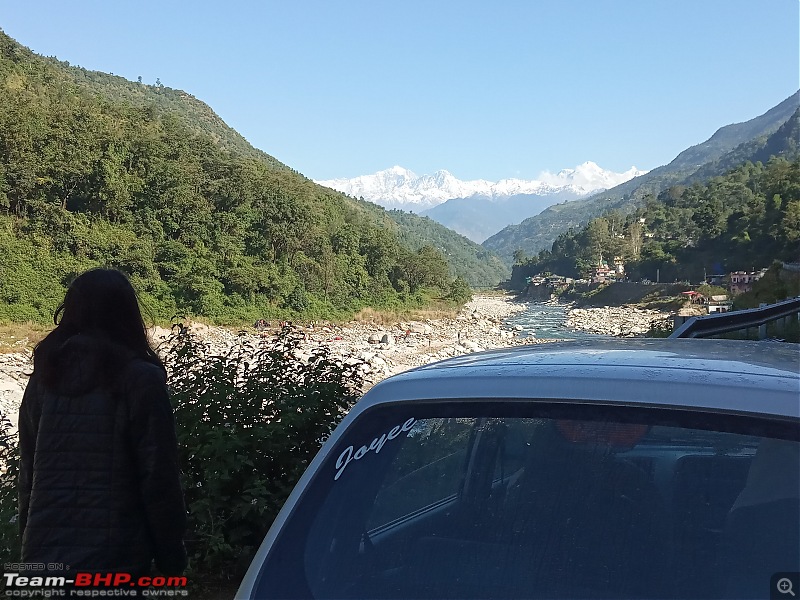
First glimpse of the Chaukhamba range, Garhwal - what you cannot see is how far my jaw had dropped!
Here is a little about me and my family: I am a twelve-year-old schoolgirl studying in Hyderabad. And sometimes when our family of three - my mom, dad, and me - need a break from the humdrum city life, we head out in our little Alto K10 for a road trip. The Alto has been in our family since I was born, and she feels like my second home. She has taken us to nearly every corner of India - 18 states and one neighboring country Bhutan, to be exact. Our favorite destination is, of course, the Himalayas. When we were in Kolkata for a while, the mountains were at arm's reach; Sikkim, North Bengal, Meghalaya and Bhutan, are some of the Himalayan states we've been to, and now Uttarakhand.
This travelogue is my experience of visiting Uttarakhand for the first time. Let me tell you how this trip came about. My parents introduced me to Jim Corbett, and after reading of his adventures, I have come to admire him. Hence, seeing the place where so many mighty tigers once roamed the forests, where the places Corbett described where full of nature's magic, was a must for me. That along with the fact that it was in the lap of the Himalayas.
Our plan was to drive from Hyderabad to Uttarakhand via Agra and stop at Lucknow on our return lap. The following are the places we ended up visiting: Jhansi, Agra & Fatehpur Sikri, Rishikesh, Garhwal, Kausani (Kumaon) and finally Lucknow. There was an overnight stay at Jabalpur on our way back. The screenshot below from Google aunty gives an idea of the places we touched in our vast and magical land.
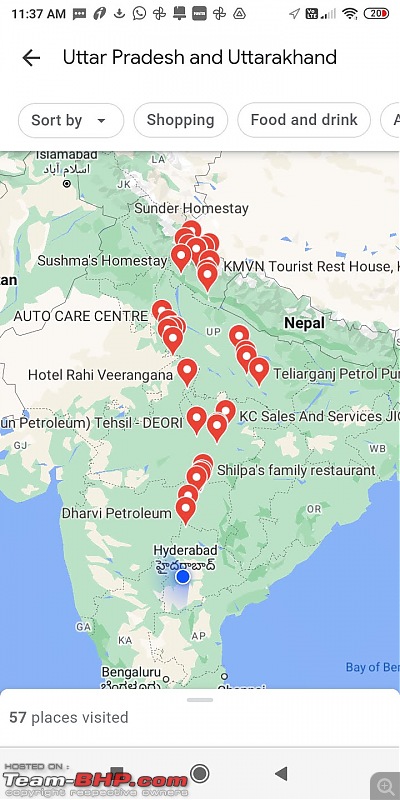
This was going to be a long haul, with many hours of driving and sleeping in the car. Therefore, from itching to start the trip that hour itself - we prepared for it mentally and physically, with much more of the former! Otherwise, we did not book any hotels from before the trip. My parents simply shortlisted a few hotels and the booking was to be done on the spot. While the adults handled all that, I sat dreaming of what to wear during the pujo, since it was October, and we were spending the last two days of Durga Puja in Lucknow!
Day 1, Hyderabad to Jhansi
Finally, the day came when we would leave Hyderabad. The three of us travel light, and this trip was no exception. The luggage easily fit into the boot and at midnight, we locked our doors. In an hour or so I bid Hyderabad farewell. Mountains, here we come!
But there was to be a couple of days before we would catch a glimpse of the mighty Himalayas. And today would be especially long, too. The night turned into day as I flitted in and out of sleep. We passed the city, and the dusty towns ensuing it, with their little dhabas lining the highway. The paddy fields, lit by the moon at night, stretched out into the horizon like vibrant carpets of green and gold during the day. The people changed, the land changed, as we passed into Madhya Pradesh. Slowly, the crops of paddy changed into corn and sugar cane, then orchards of thin, white stemmed trees replaced the fields, before they morphed into the dense forests the state is so famous for. Trucks passed by, and you could guess if they were private or owned by a trucking company - since every truck driver decorated his own vehicle like a bride!
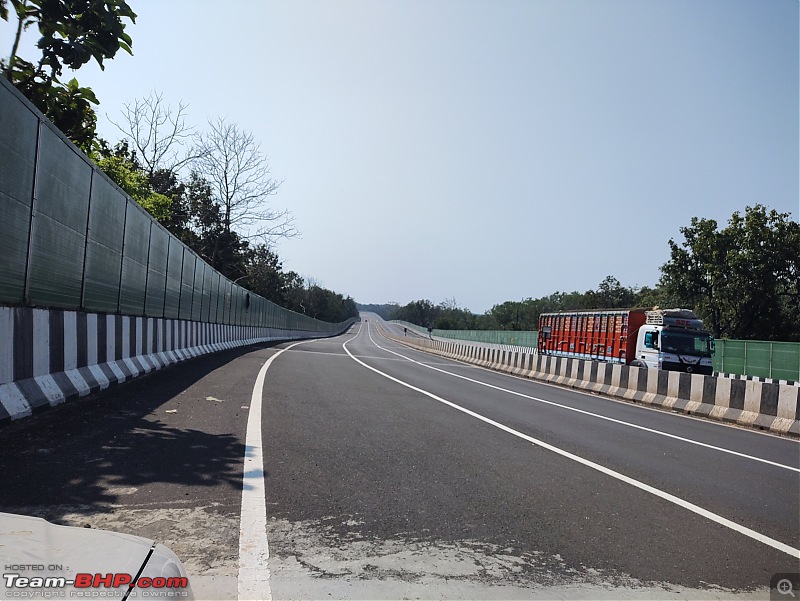
Road above and animals passing below!
Soon we entered the Pench tiger reserve. The four-lane highway until now was excellent. Although the forest would have looked more scenic without it, the road was an impressive feat of engineering. There was also a high green painted fence on each side, which was to prevent the animals from deciding to take a walk on the fast lane. But this privilege of excellent roads would come to a painfully bumpy end; just as we left the reserve forest and entered the stretch to Sagar in MP, the road turned into a gut shaking monstrosity. At least that was what it felt to me at the time. Remember that I call the cramped back seat my home and my legs were cramped, plus the fact that I had already spent half a day in the car, almost nonstop. The miserable road conditions didn't help when our car kept dipping and bouncing in and out of potholes. The cows on the road were the icing on the cake. They dozed on the smooth parts while we struggled through the portions which resembled the surface of the moon. I had no choice but to sleep through this, as I absorbed the bumps better lying down. Hence I missed much of what the road had to offer by way of scenery. But one thing I remember, that is every time I sat up, we were approaching a toll plaza. They probably felt that the rollercoaster was so enjoyable that they should charge as much as an amusement park.
Midday went by and the sun came and turned up the thermometer. A lunch break at ''King Ka Khana'' did a lot to improve my feelings and I set out with renewed enthusiasm. I won't bore you with the rest of the drive since nothing much happened after that. The road became more tolerable, and when we finally entered Uttar Pradesh at dusk, the highway to Jhansi was just superb! At 10:30 PM, we ended our drive, after spending 22 hours on the road! Now I could do anything! My parents checked us into the Rahi Veerangana Tourist Bungalow, an ancient Uttar Pradesh Tourism Department hotel at Jhansi, where I collapsed into the bed. I didn't have it in me to do much more than take a bath and eat dinner. Dal fry, aloo matar curry, rice and chapatis sealed the deal for me; I was Snow White for a full ten hours and I woke up, not to a true love's kiss but a shove from my mom (trust me, it was needed).
Day 2 Jhansi fort visit and drive to Fatehpur Sikri
The morning brought a yummy breakfast of stuffed omelets and hot and crispy parathas. This is my review of the Jhansi UPTDC: The building is old, but the stay was heartwarming. The property is very nice, and the garden is a place to relax and have tea (or lemonade in my case). The food was tasty and the location was convenient too. But the best part was the hospitality. Most of the employees had worked here for a long time and had many years of experience. Everyone was amiable and chatty - old fashioned gentility, a rare quality these days.
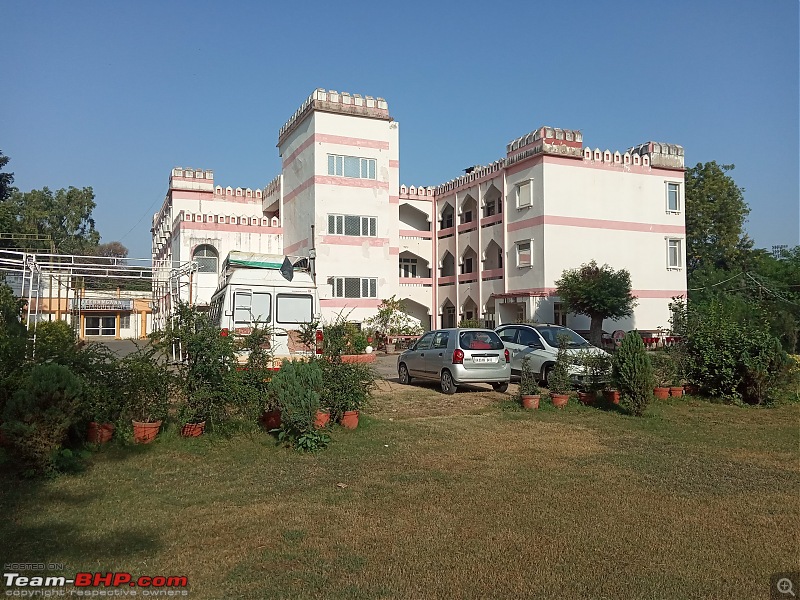
UPTDC Jhansi
This is not a place for people looking for luxurious or opulent rooms, however. Our room had a warm bed, furniture to keep our stuff and hot water - which was all we needed.
Let's resume our trip. Today we were visiting the Jhansi fort, well known as the setting for one of the first battles of our freedom movement against the British, led by the courageous Rani Lakshmibai. The city of Jhansi is charming with its steep, hill like roads and houses built huddled together, reminding me of the pictures I had seen of Grecian cobbled streets. The fort was situated on a vantage point, and you could absorb the view of the curving brown moat walls and the little city stretching out like miniature doll neighborhoods, side by side.
And on this pretty day we entered the fort of Jhansi. And let me tell you my first thoughts - the steps were marvelous! There is something you should know about me before we go any further on this trip, dear reader - and that is my fear of steep climbs. Yes, my friend - hikophobia! It's not that I mind climbing up a little hill side or a rocky escalation; it's coming down that gets to me. Come with me to a steep trek and you'll see me bounding up the way, but on the way down you will know what extreme social distancing is. You might have to cooee to reach me, I'll be so far behind. There is always fear of where the next loose stone is, or if the fallen pine needles are especially well nourished and shiny this season. And old, crumbly rock stairs in forts are my pet peeves. What joy when I found that in Rani Lakshmi Bai's home, I was pampered with perfectly solid, spaced staircases! It is now in my list of favorite forts. Even without the staircases. It had such a charming atmosphere and was so well preserved so that I can still imagine the royals strolling through its intricate true arches and its manicured gardens. It was a perfect place to play hide and seek, with its passageways and a little niche at every corner. Indo Islamic architecture will always have a place in my heart.
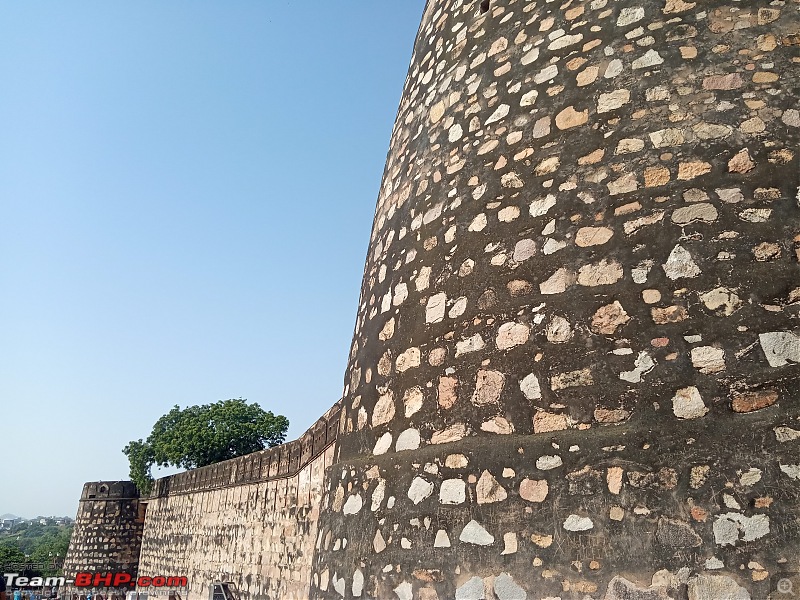
Imposing ramparts


Inside the Jhansi fort
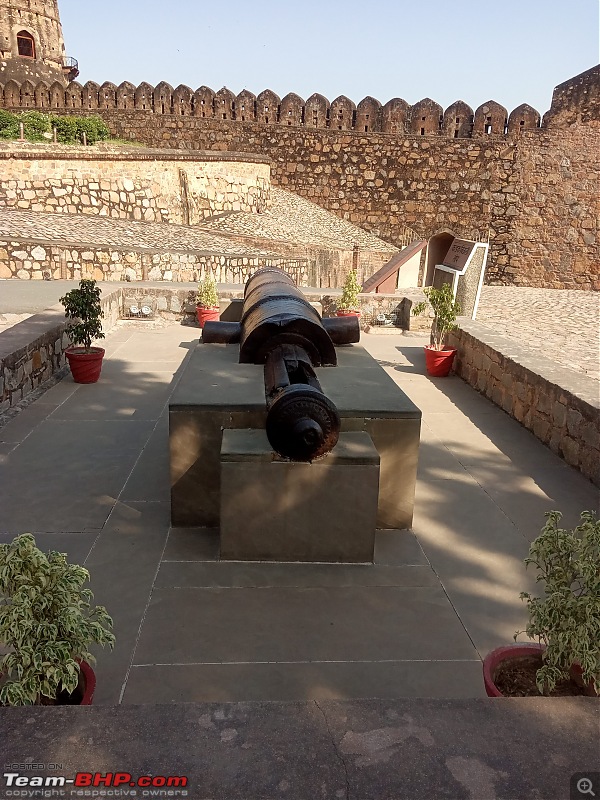
The kadak bijli cannon
We had to finally leave the lovely views of the fort and continue our drive up to Fatehpur Sikri. This five-hour drive was a mere walk in the park compared to yesterday's marathon. We reached the Sikri by past midday and checked into the Gulistan Travelers hotel there - another UPTDC property. This place was like a fort in itself. I will come back to it later, since it had a rather interesting set of people.
We were to visit a second fort today. Fatehpur Sikri, a monument I had read about for years in my history textbooks and lost so many marks on. It was also something Akbar built on a whim for his baby son, taking two years to build and one moment to abandon. But how to remember so many dates, especially in an exam!
If there is a time to visit a fort, it is before dusk. The sun is waving us a red goodbye, the shadows are stretching out, and for some, the souls of the people who once lived here, step out of the dark niches and come out to have tea. This was when we were sitting in front of the king's bedroom. The corridors, the pavilions, the open rooms, all in red stone, from latticed shutters and embroidered sunroofs - buildings of opulence, luxury, and craftsmanship. All this Akbar built for his child who probably couldn't yet tell the difference between his shoe and the yummy kebabs people ate in those days. Fatehpur Sikri is big - 3 km long and 1 km wide - for a home. Walking through the large courtyards and imposing buildings, the Sikri felt like more of an administrative structure. But where it felt the most personal was at the library/bedroom of the king. There was a lovely little pool in front, with a narrow path built a foot or so above it on all four sides, from where they led to the center. And at the intersection, there was a small square balcony with low railings bordering it. Four seats, looking like carved cushions, were built around a tea table. Once, swans would have relaxed in the pool and perhaps ranis of a similar beauty would have graced the seats above, sipping on wholesome lassis. The image was all too real.
Of course, we couldn't enter the balcony as it was off limits, but I was quite happy admiring it from the steps of the library. The soft evening sunlight shone on the faraway prayer hall. At that time, an army of college students, in their most chic attire, swept through the grounds, led by a rather overdressed guide. Soon, the serene atmosphere was submerged by Delhi youth, coming in small clusters joined by one big cluster. The guide was saying, in broken English with snatches of - ''This was where Tansen sang while the king had tea with his dames, and oh, look there, near the third pillar, that was where two of the ranis had fought with each other about who was more favored by the king.'' Two or three nerds in the front nodded their head and the rest of them were chattering and guffawing as if they had no clue where they were. Meanwhile, the poor teacher in charge was being left behind and his reprimands were heard by no one but me. It's not every day where you get to see something like this. But the party left as suddenly as it had appeared, and it was time that we did too.
But the tomb of the man who inspired the emperor to build the fort was certainly not to be left out. Akbar visited a mystic at his home in the Sikri and asked him to pray for baby boy. With the mystic's blessings, sons were born to him and in his joy, emperor Akbar built an entire fort in Sikri. And in this fort was the magnificent tomb of the mystic. And undoubtedly most of you know that the tomb belongs to Sheikh Salim Chishti. A little way of the center of the fort is a large pavilion - a courtyard enclosed by a tall wall bejeweled with Islamic motifs and minarets. Inside, there are two buildings which form the wall. One of them is a viewpoint which looks out to the city. An arche opens out to a balcony from where one can see the part of the city which has more trees than houses. The purple bruised sky curved down to the tree lined horizon, with waves of trees and houses. I could see the moon's upturned face, its sharp chin pointing to some random stars. A view which most royals would have taken for granted.
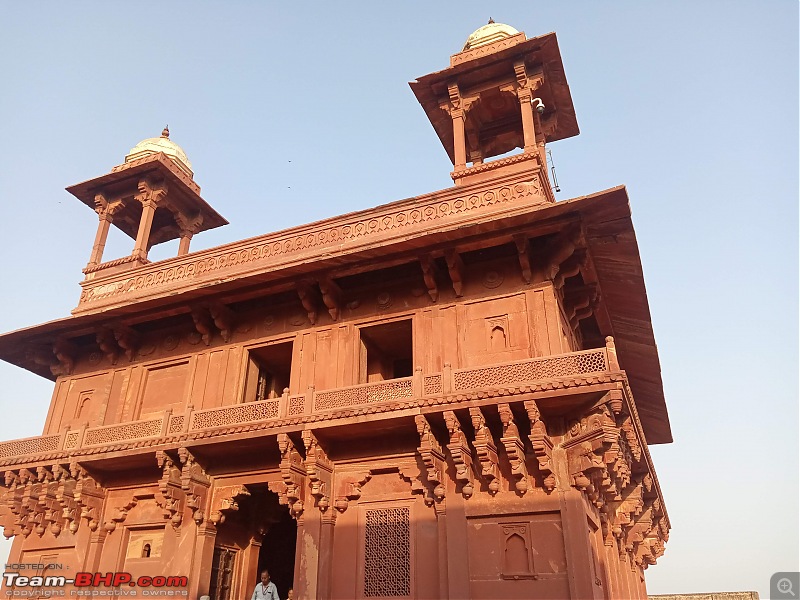
ambitions of an empire - Fatehpur Sikri
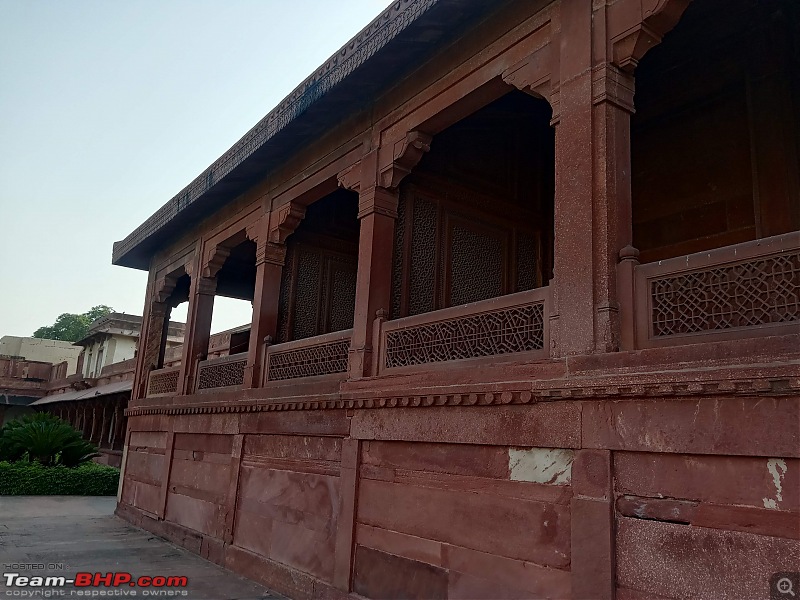
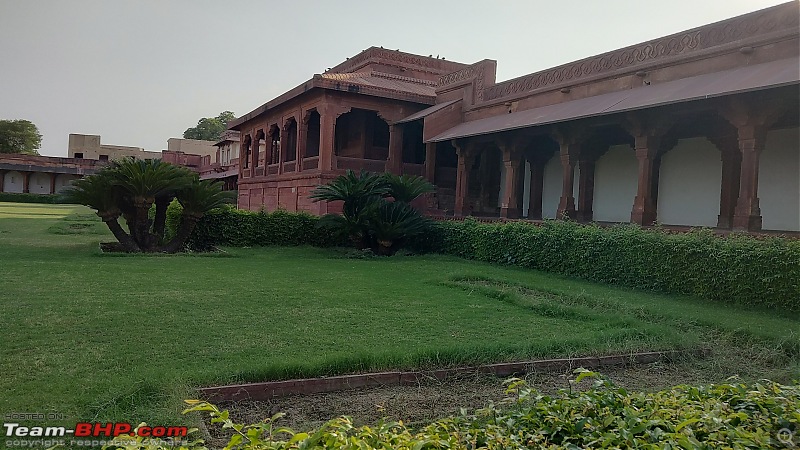
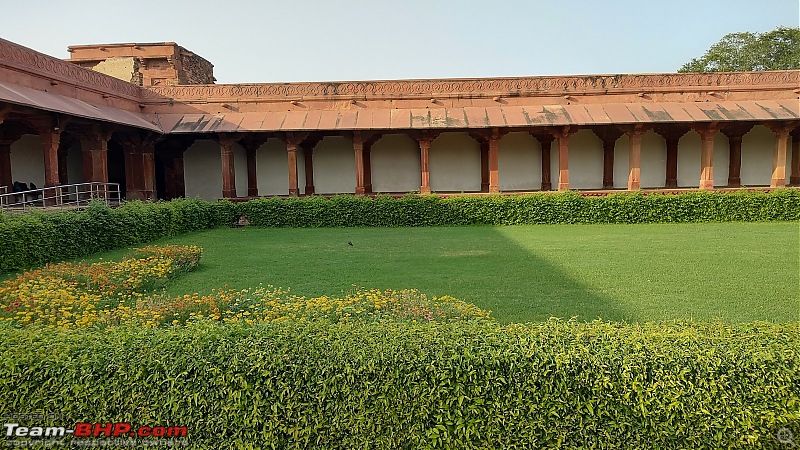
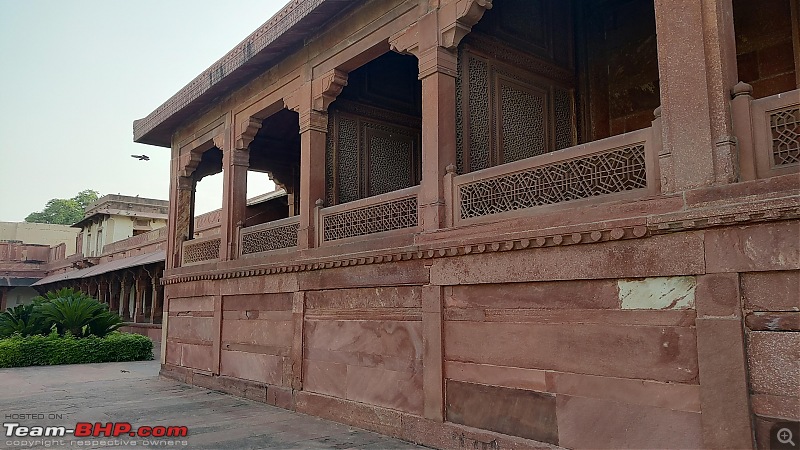
The second building was a beautiful mosque. The front wall curved in to meet the entrance, and was painted with religious scenes, probably from the Quran, of birds and ladies and warriors. It had gilded doors which were closed at the time.
At one side, stood a marble building, the tomb of the Sheikh himself. It glowed in contrast to the deep red of the brick around it. Bright light filtered out through the marble lacework and entrance. A kindly old man with a withered face beckoned us inside. The room inside had a floor inlaid with different semi-precious stones, while the tomb was roofed and fenced by old, carved wood. The sarcophagus itself was heaped with luxurious and richly colored pieces of cloth.
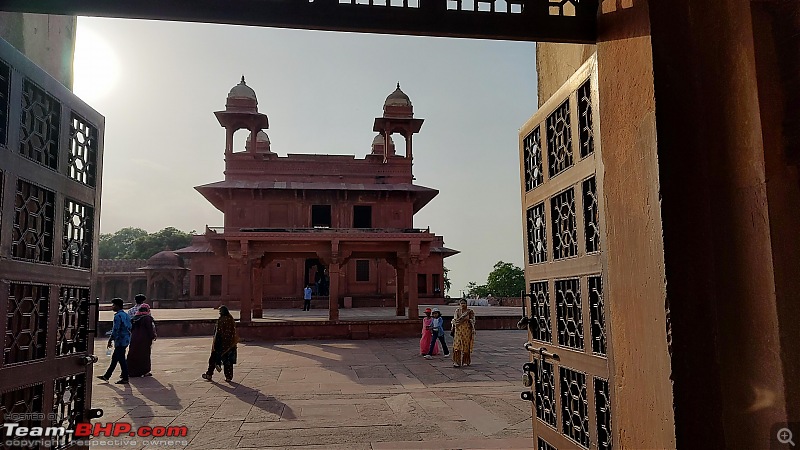
We ended today's tour with this tomb. Now let me tell you a little about the hotel we were staying at -
Walk through the reception and you will see a big grassy lawn with a square boundary which houses the rooms. It is all single storied, and forms one whole wall, a lot like a fort. Moreover, everything is made of red sandstone, and the pillars and edges were embroidered with carvings. So, throughout our stay we felt like we were living in Akbar's fort! The ancient feel was even more pronounced when we found several male peacocks flouncing about the lawn and roofs.
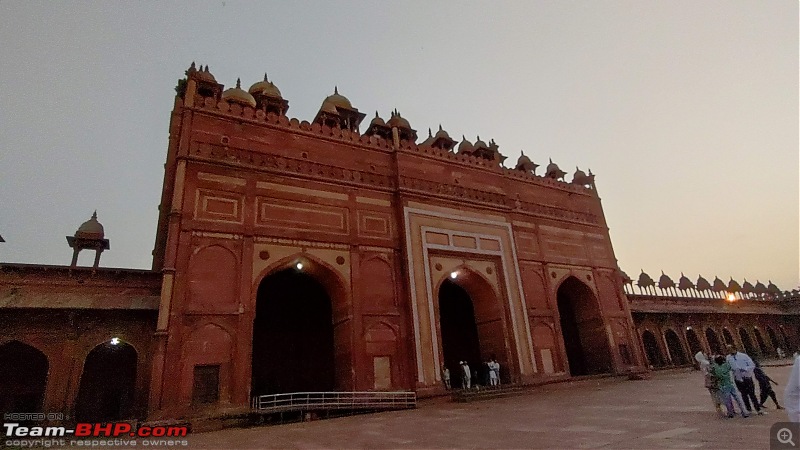
Tomb of Salim Chisti
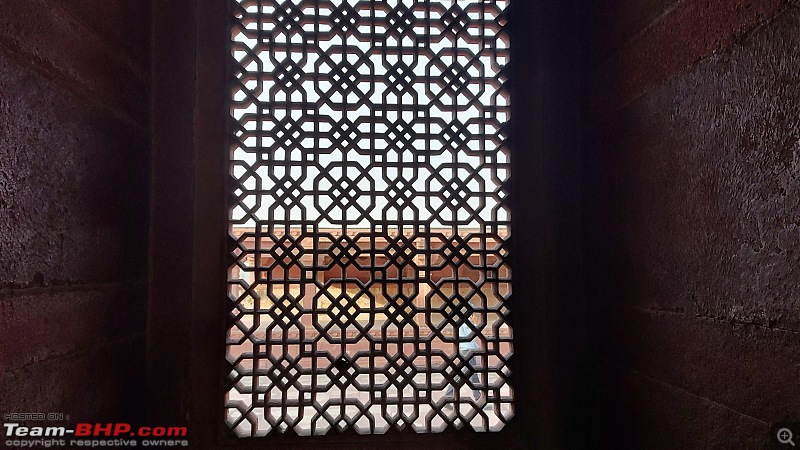
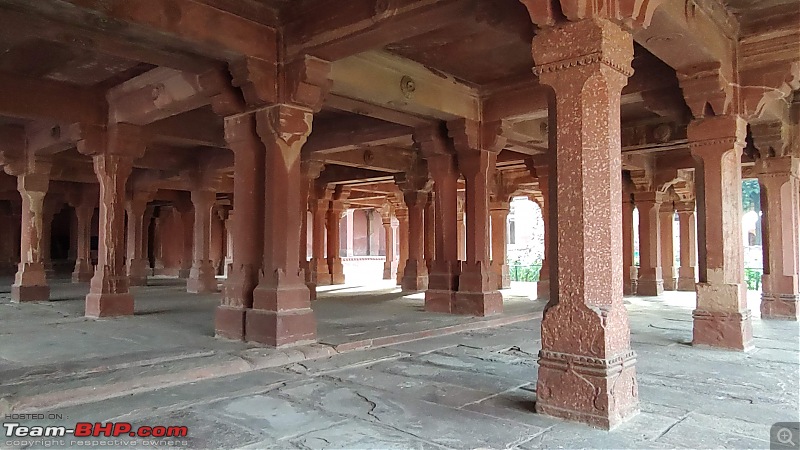

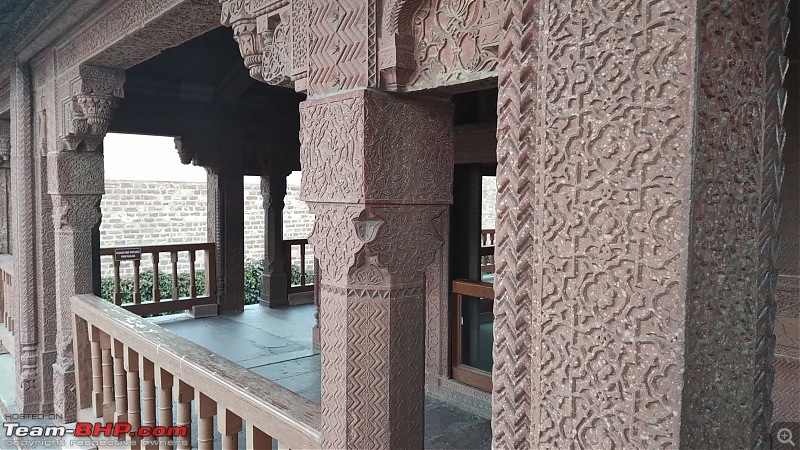
breathtaking art
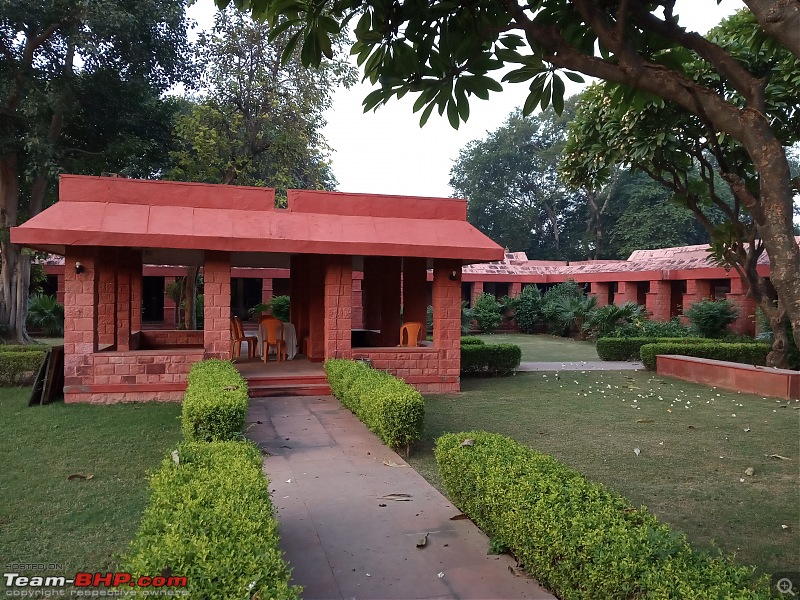
Gulistan Tourist complex - inner courtyard; rooms border this lovely lawn
Once we returned from the fort, night had replaced day and the crickets were doing choir practice. It was very still and I came out to collect some ratranis (which are a variety of jasmines) which had fallen from the big tree at the east end of the lawn. The place had an eerie atmosphere. As I was bending down to pick up a flower, it was all to easy to imagine a petni witch looking down at me with her frizzy hair and twisted feet. For those who don't speak Bengali, a petni or pretni (hindi) is a female ghost. Or was I sensing one up there just imagining things, like in the movies? The sensible part of my mind was in war with my imaginative side, so I hurriedly picked up some damaged flowers and went back inside. Whew!
And then it was time for dinner. We sat down in the dining room. Many beautiful paintings were arranged in the circular room (the architect
was hung up in adding embellishments to his work). There were only three people we could see working in the hotel - the old receptionist turned waiter, a cook, and an accountant type gentleman, who did most of the bill calculating. As the receptionist (a wiry middle-aged man with a moustache and salt and pepper hair) was serving the food, my mom asked him about the paintings - she particularly adored one of the Madhubani prints. The waiter took a step back and with a contented sigh, seeming to forget my mom's question, told us that a scene of Pardes had been shot right here. The director of the movie, the esteemed Mr Subhash Ghai, had stayed in our very room during the shoot. Thrilling, isn't it? With that, he slunk into some corner, leaving us with that interesting incident in this unlikely place. My imaginary encounter with a petni had roused my senses and I was acutely aware of my surroundings. While I was munching my butter chicken and tawa roti, I quickly glanced through the whole room from the corner of my eye. And guess what I found, that eerie night in the deserted, dimly lit dining hall? The cook was standing in a corner and observing our every move, ready to pounce when we needed an extra roti! In this day and age! This was all very mysterious.
And a little about the room. It was very shapely. By that I mean it had several different shapes making it up - the bathroom was a triangle, for god's sake! the signature style of the architect. The bed was great, the walls were interesting, etc. etc. It was comfortable, and really nice. But at night, when I was about to fall asleep, I heard a muffled, banging noise being made repeatedly. My heart started galloping and I quickly woke my mother. She waved me away and said it must be from the AC. And so I was too tired to bother about it and fell asleep with a witch or a kidnapper skulking outside the door.
But the thing is, the next morning, my dad said that he had heard several scratching, thudding sounds during the night. Could it have been a maneater?
Day 3 Agra Fort and the Taj Mahal
Today I was to have my first glimpse of one of the seven, very wonderful wonders. There was barely any distance from Fatehpur Sikri to Agra and so we had a whole day for sightseeing. Our first stop today would be the Agra Fort, also built by Akbar. Let's begin!
Agra Fort
This was our third and last fort on our trip. It was also the most fascinating. All of the early Mughal emperors had lived here, leaving their unique marks on the monument. Each little thing that an emperor had built here reflected his style of ruling, through his style of living. One built a thick heavy 'chain of justice' made entirely out of gold while the other built a marble palace only for his mistresses. The British had also selflessly added to the history of the fort by misplacing an old treasure here. This structure is soaked through to its foundation with the might of the greatest powers of India, like it symbolizes the most human traits and desires.
It was a sunny morning. The three of us were all dressed up and ready to rock. We had just nourished ourselves with hot masala pulkas and I was in a great mood. Armed with my incognito mode cap, I was prepared to walk straight through the troops of necklace vendors and guides. We defied the "madam buy this it's great" and reached the palace gardens, trinket less and undefeated. Yeah baby!
The outer regions of the fort were the usual red, speckled sandstone. It had Jewish stars and fish engraved into the upper arches, with the creamy white limestone trimming every little niche. Crowds of Americans, Japanese, French, Spanish, Arab, and of course, Indians were milling about in little clusters or big tour groups, mostly headed by guides. Many of the people, dressed in bikini tops or swathed in white cloth for desert like weather, provided contrast to this once, most tasteful and expressive sanctum.
Grand archways opened up to patterned courtyards with little castles standing at the boundary. Motifs, arches, and pillars morphed into those of different times and styles. Stars and fish were replaced by floral and geometric patterns on the walls. A waiting room could have been a palatial wonder. Buildings reached up higher and higher, adding new layers to the older structures. The higher we went, the more could we see marble left by Jahangir. The Mughals have given so much to us; each ruler an entirely different character. I believe that they have contributed most to the art and culture of India. Luxury, art, culture, love; India would have been incomplete without the Mughals there to flavor her with these.
We passed through innumerable castles, palaces, gardens, balconies, until we finally reached the top of the fort. It was the most luxurious part of the fort and made entirely out of marble. Much like a snowcapped mountain, except it was extremely easy to climb! The original top part of the forest was sandstone, built by early rulers. The marble addition is attributed to Jahangir, who is arguably one of the most unconventional rulers of the Mughal empire. Why do I say this? From my experience of Mughal forts, the highest point of a fort is reserved for the bastions, watchtowers (or watch-minars, in this case). If it is the innermost point of the fort, it is meant to be the private rooms of the king and his ranis. But Jahangir, being the unique character that he was, had given up the apex of the fort to his harem. In these cool rooms were tear drop chandeliers, floral pictures, fountains, and once upon a time, some of the most beautiful women had lived.
But the bandis (a word for harem women) didn't have the entire place to themselves. There was also a balcony for the king, overlooking the Yamuna, from where there was a chain extending to the shore. It was three kilometers long. If any of the common folk were being treated unjustly or being harmed, all they had to do was jangle at the chain and the king would hear it and come running to their rescue. And guess what the chain was made of? Gold. Pure, heavy, shimmery, three kgs of gold! Incredible, is it not?
We left the balconies and gardens of the top and returned to the entrance. It was noon. People were filtering through the great gates through which once only royals had passed. It was time to leave Agra fort, so I waved it a teary goodbye.
A Wonder of the World
The Taj is one of the greatest structures in India, both in scale, efficiency, architectural prowess, and beauty. No wonder (or it is a wonder!) that it charmed billions of people, including me. I was bubbling with excitement. Taj Mahal, here I come!
Thousands of people have written poems and essays and paragraphs and novels about the Mahal. Countless historical pieces, romantic fiction and tragedies have revolved around this place. Certainly, there is something so unique about it that appeals to every kind of person. I believe that no matter where you're from, or what you do for a living, or the things you like - there is some part of this monument which will always touch your heart. Like every good piece of art, the Taj Mahal unites us all in its beauty.
The marble mausoleum is surrounded by the Jama Masjid on the left, and a waiting room on the right, both noble and awesome structures. They provided a beautiful contrast of red and ivory to the center. And in the center stood one of the most touching works of art I have seen. People thronged and pushed me. My view was blocked by people taking selfies. Young people in loud clothes danced around making Tik Tok's. But one could hardly notice anything else with this magnificent edifice standing in front.
There was a little marble stage a hundred or so meters away from the mausoleum. It was a burning hot afternoon, and I was sweating through my light kurta. We climbed the steps and watched youngsters do a runway show in front of the blue water canal. I got this idea of sitting down despite my mother's warning of heated stone burns. And guess what? the stone was cool and wonderful! It was as cool as it looked; giving of a mellow light and translucent, watery effect. And yet this soft beauty has remained delicate even after four centuries.
I needn't describe the building in detail since all of you would be able to visualize it. The embroidered doorway, the four inner minarets and four minars. All in delightful proportion, a dome sits without any support at the top. Even though money and people were no concern for a Mughal Emperor, one could feel the love Shah Jahan felt for Mumtaz. If not love some deep, delicate feeling that the emperor felt for her when he built the tomb. That day I felt that the Taj Mahal embodies the beauty of Mumtaz Mahal. Azures skies and ivory carvings. The age of kings and kingdoms seems so far away; yet so many of their traces seem so much more artistic and human than that people of today.
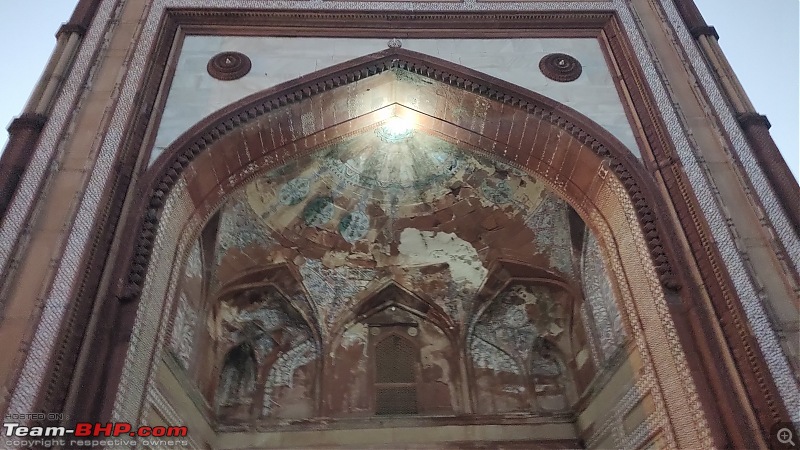
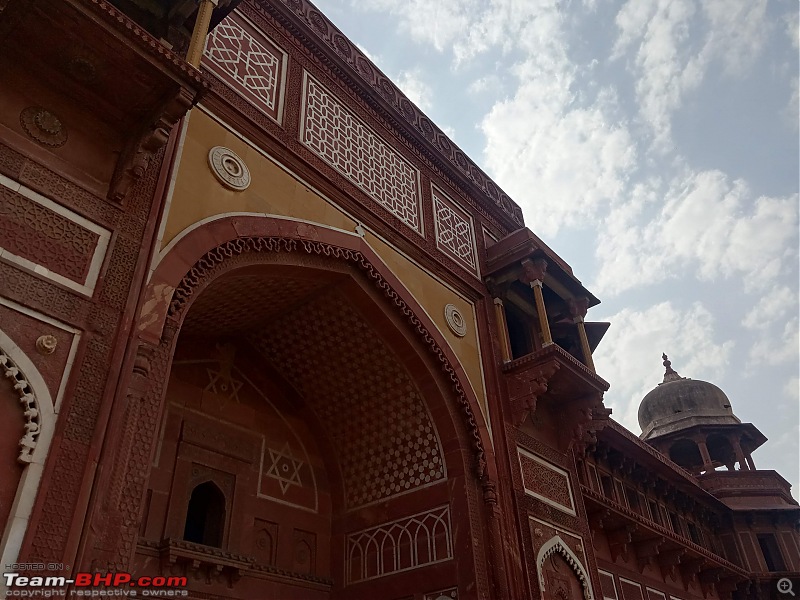
We had to bid Agra farewell... But after two years of separation from the Himalayas, we were drawn back to the divine mountains.
''And the last puff of the day-wind brought from the unseen villages the scent of damp
wood-smoke, hot cakes, dripping undergrowth, and rotting pine cones. That is the true
smell of the Himalayas, and if once it creeps into the blood of a man, that man will at
last, forgetting all else, return to the hills to die.'' -
Rudyard Kipling had once so truly said, and the same happened to us; the mountains had moved us so deeply that a part of us will always long to come back here and have its fill of it.
And so it happened that October morning, we were coming back to the Himalayas. Rishikesh was just seven hours away. Early in the evening, as we got close, I felt the faint mountain breeze and I was filled with happiness and contentment. The first few hills came into view - grassy and curvy. It was like meeting an old friend.
I saw the Ganga, the Yamuna and finally we entered Rishikesh, which I found to be a quaint little town with views of the mountains at a distance. It was dark by the time we reached our homestay, located on the third floor of an apartment building in a quiet neighborhood. It will rank in the top three homestays/hotels I have been to. I had a nice bath and relaxed in the cozy bedroom with a hot cup of chocolate milk and a book. The hills dotted with lights of Himalayan villages could be spotted from the balcony. I woke up a new girl and was totally ready to meet the mountains.
Bhagirathi, Alaknanda, Mandakini, Dhauli Ganga, and Pindar - these are the five headstreams of the mighty Ganga. All these rivers are born from the glaciers of Uttarakhand to form one mighty river. Bhagirathi and Alaknanda meet and join each other at Devaprayag, becoming the fast flowing, minty blue stream that is Ganga. Bhagirathi, Alaknanda, Mandakini, Dhauli Ganga, Pinder - all of these rivers would be with us throughout our stay in Uttarakhand. One or the other would flow by us on the road and would accompany us on our journey through the land of the gods, or 'Devbhumi'.
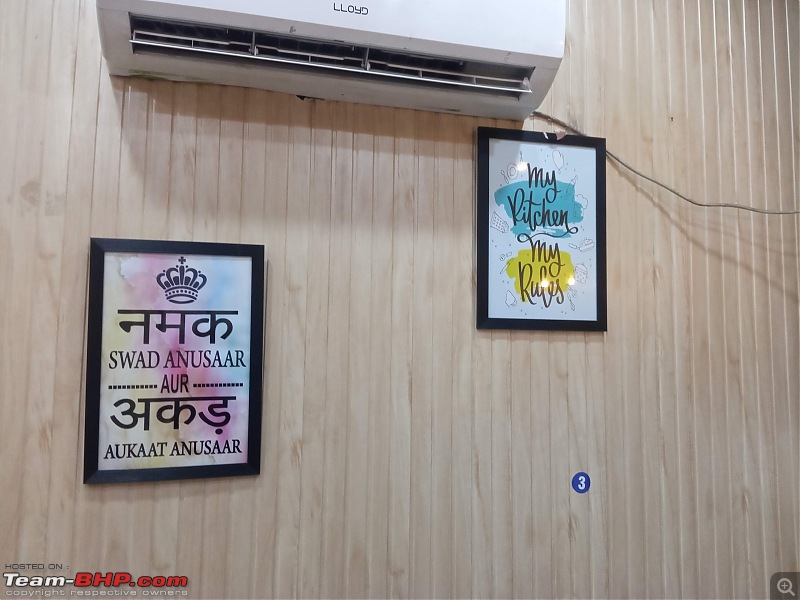
Clicked at a small cafe in Haridwar, where we had yummy momos and noodles
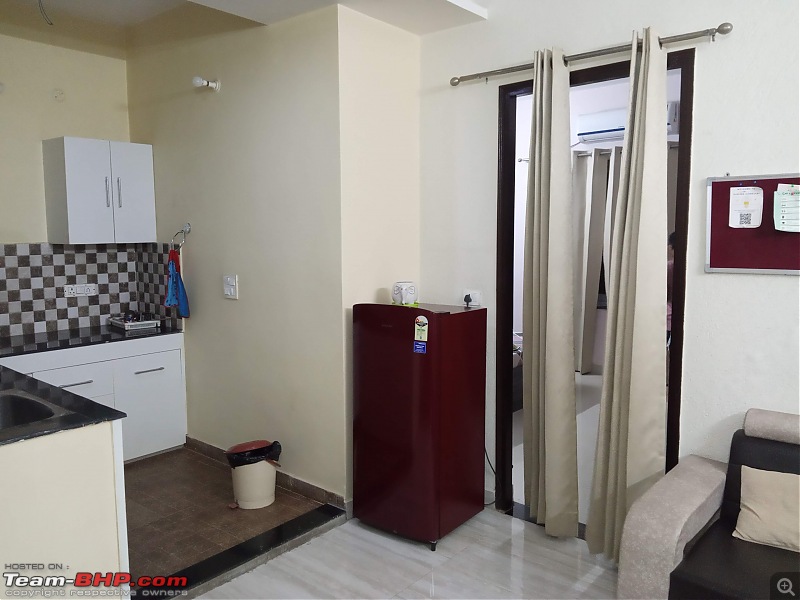
At our Rishikesh homestay

climbing from Rishikesh
Day 5 Rishikesh to Harsil
Today was to be the day we were to climb the mighty mountains as we drove through Uttarkashi to Harsil. Small hills and straight highways slowly started getting a little higher and a little twistier. Before I knew it, I had put on five extra layers of cloth, my feet and face freezing in the icy cold wind, and I was standing in front of creamy white topped mountains. Tall pines ascended from the grassy glade I was standing on, much like the little glades tucked away in the mountains, which became less grassy and smaller the higher they went. I was at a thousand meter elevation and it was only going up.
A giddy drive and several pine forests later we were finally at Harsil, which is a high altitude village with an army base. It was already dark and my parents looked around for a place to stay. A young chap recognized us as potential customers and approached us, offering to guide us to his homestay. The place was nice, several plain cottages within a yard surrounded by apple trees. It was biting cold and I shivered my way into the room. We ate a simple but tasty vegetarian dinner and I was soon under several layers of thick blankets.
But in the morning, I was feeling human enough to dress up and get outside. The discomfort from the cold was made up by the stunning view outside. A panorama of snow capped mountains, rugged but divine, reaching up and touching the sky. Not a cloud in sight. We had missed this view in the dark, but now the hills chose to unveil themselves completely. The snow shimmered on the mountains and gave then a halo of light. The true sky scrapers of nature. Just within the gates of the property was and orchard of apple trees. Round, dark and rough apples hung from all the branches. They did not look so appealing, but one bite and it was heaven. A heavenly apple from Heaven.

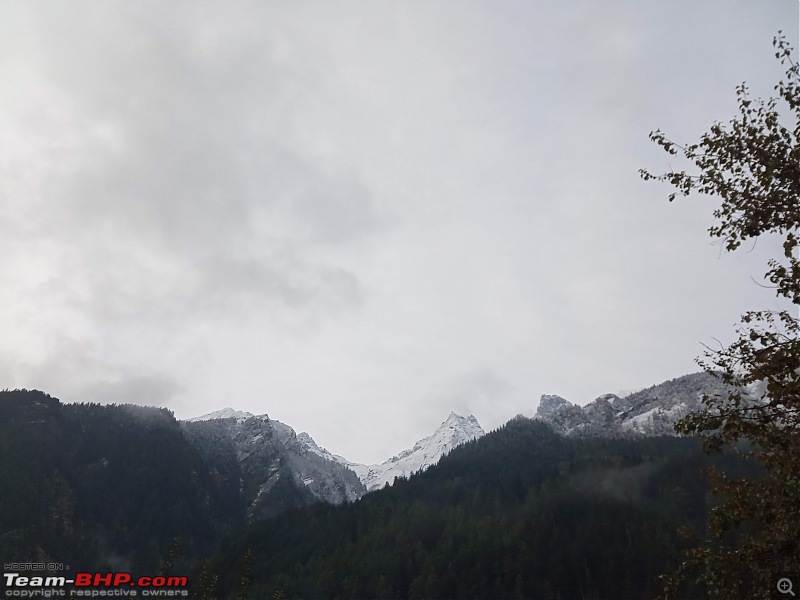
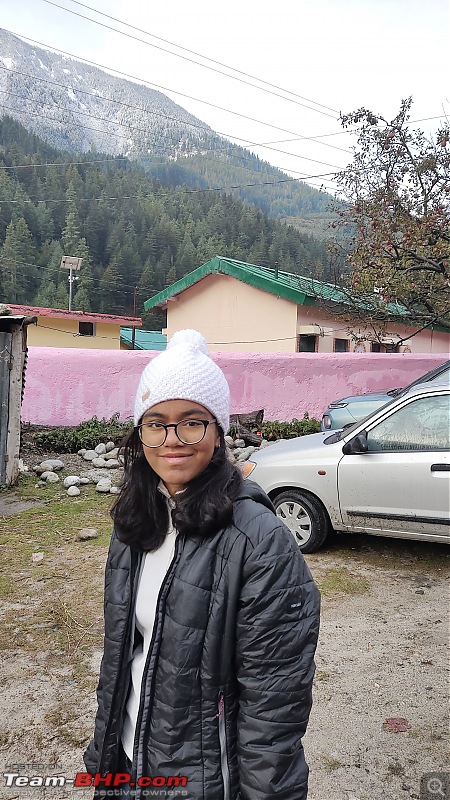
Our Harsil homestay, happy and warm
Day 6, The birth of a river - Harsil to Gangotri, Gartung gali and back
On our itinerary today was a very special place. Just like the Himalayas had protected India from becoming a cold desert, the Ganga had made our country fertile and fruitful. It is a marvel of its own. Starting from the crest of Himalayas, it travels across our country, living through a wealth of places and times, making them richer. And today we were seeing Ganga at her purest. Gangotri is the birthplace of the river Bhagirathi. We weren't trekking up all the way to the glacier, but were going to the Gangotri temple, which was at an hour's drive from Harsil.
To get to the temple, we had to take a slippery trek through a temple bazaar. The concrete road went steeply uphill with two rows of shops selling prayer items, effectively blocking out the view of the mountains. Shop after saffron shop sold prayer beads, idols, little rings, sindoor, incense lamps, lanterns and much more, all in shades of bright orange, burnt brown and crimson red. This market extends about a couple of hundred meters up until the steep road gives way to a clearing. On this clearing is the temple. There is a carved scene of the Ramayana on one end, a small shiva temple, with a bigger Vishnu temple beside it. On this platform were no trees, only mountains on every side with green forests creeping up the tree line. Then brown rock emerged from under the greenery and finally gave way to the eternal snows. The peaks were hidden above the clouds.
I felt at that moment that these mountains were much like the god which all of us believe in. Maybe this how the belief in a higher power was first given a form, an idea. Someone saw the mountains, and would have thought, ''Wow, these are so powerful, so beautiful, so out of this world, and yet so reassuring - isn't this something which is so much greater than us?'' And maybe that same person had the idea of building a temple here. Who knows? The Himalayas can do that sometimes.
A flight of steps took us down to a lower platform, where barely ten meters beyond a railing was the Ganga. Rushing past in a careless manner, the river was a lovely minty blue-green color. I was looking at one of the most wonderful water bodies on Earth. Geographically, it is a river which directly gives life to so many. It creates ecosystems of its own. Life has evolved by the basins and shores and under the surface of the water course. A sip of pure water from the Ganga is believed to do wonders for the human body. The river provides livelihood to nearly half a billion people. Cities, kingdoms, the history of this great nation has been shaped by the mighty river. India would not be India without Ganga.
And here I was, just a few kilometers from her birthplace. A child of the Himadri. It was one heck of a thought. I sipped on some hot, sugary black tea, so kindly offered by the temple people to visitors. It was lovely. Stairs led down from where the temple stands to the bank of the gushing Bhagirathi river where it is possible for devotees to take a dip in the holy and refreshing waters. Some awfully tough women had stripped down to their petticoats and were soaked in the freezing cold water while I was shivering in my thick jacket. The three of us made our way to the edge where there my dad bent down to shower some holy water on our heads with his cupped hands.
How many in India would have this privilege of touching the cool waters of the holy river just when it began it's journey? In our years in Calcutta, we used to drive down to the edge of the Hooghly river. What a difference, that muddy, unclear water moving along the sand bed! It was hard to believe that this was also Ganga, a young, unexperienced version of it, yet to see the things Hugli had.
Refreshed and exalted, we returned to our Alto. I had yet another beautiful destination for today!
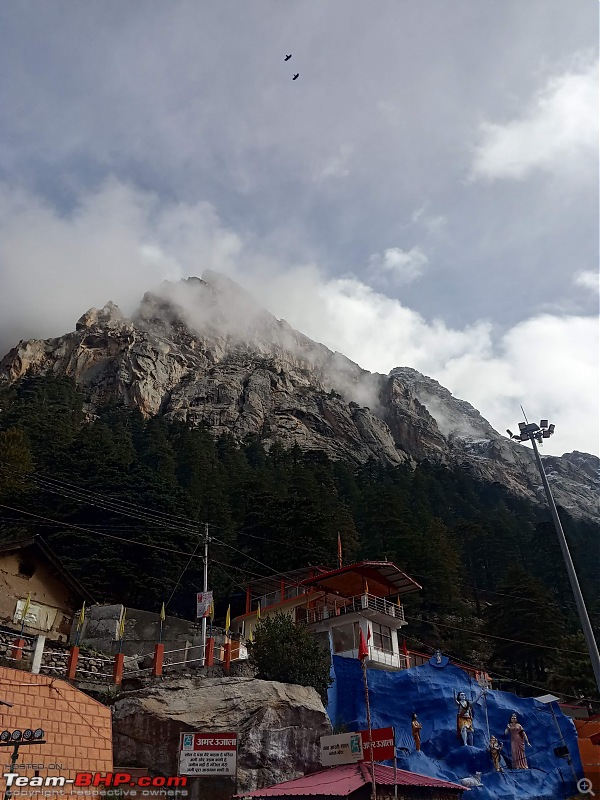
The Gangotri temple
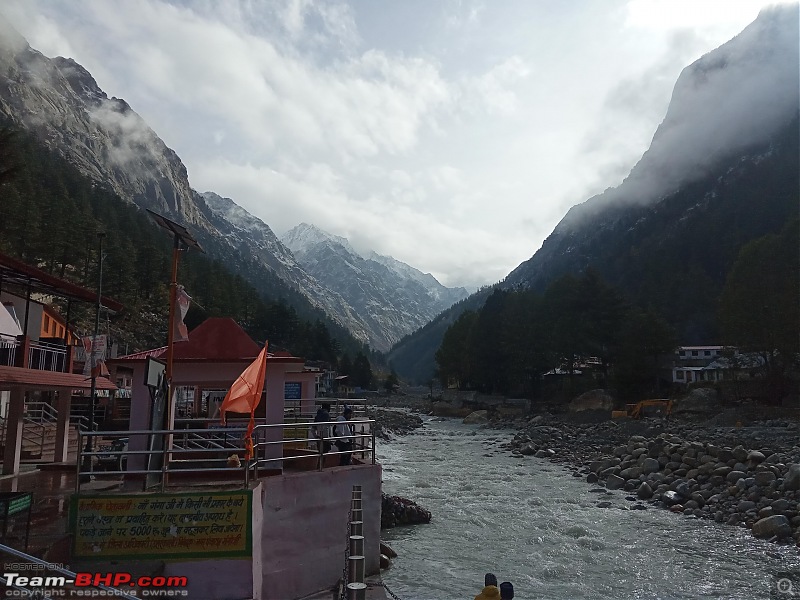
The Bhagirathi river
The World's Deadliest Skywalk
Gartung Gali is an ancient bridge constructed by the Pathans of Peshawar in the Nelong valley. This is actually a trek running across a nearly vertical rock face the whole way. After hiking for some time, one will reach an old wooden bridge built alongside a sheer drop of a cliff, 150 years ago at 11,000 feet or 3,352 meters above sea level. For centuries together, the Bhotiya tribe of Uttarakhand and the Tibetans have trodden this path as the silk route, trading and exchanging jaggery, salt, spices, and much more. And all along this near three-kilometer trek flows a young stream that was part of the Bhagirathi River. And today, we were going to climb this historic trail, rich with stories of nature and people. Let's begin!
The first section of the trek was almost level. The large mountain had been cut to form a ledge. Between the pines lining the edge, we got extensive views of Nelong valley, the mountains striding far, far away. Splashes of gray interrupted the reddish rocks of the ranges where a landslide had broken off the outer rock, forming a scree. The lower parts of the hills were flanked by thick greenery, and higher up there were meadows dotted with oaks or pines until they disappeared into rock. They stood together, dangerous and unpredictable, yet with their solid and immovable aura, they were gentle giants in my mind.
To my left was the ascending rock face. I had a wealth of life forms just beside me, ready to be observed - young flowering shrubs, several different types of moss, algae, leaves of endless variety, fallen pinecones, colorful lizards or chameleons which blend into the rocks beneath. Marble, granite, and many different types of rocks make up the hillside. The path itself was made up of a rich black soil, stones bordering it. Of course, I was more distracted by the steps I should take. A little later, the climb started becoming a little trickier, with fallen pine needles making the path slippery, and more jutting rocks. But, Dear Reader, please take most of this with a teeny-weeny pinch of salt, since if you have read all my words till now, you would know that I tend to overestimate a trek. Trust me. Anyways, since I was taking a little too much time coming down from a particularly steep part, my parents threatened to leave me where I was and move ahead some distance before I caught up. With a sufficiently hurt pride, I came scrambling down and raced ahead of my guardians.
In a little while, I caught a glimpse of the stream rushing by two hundred or so meters below. It was bright blue, and its color stood out like a gem in the forest. We could hear the sound of rushing water despite the fact that the stream was very narrow at that point. The sight of the river renewed our energy and I continued with enthusiasm.
After fifty minutes of trekking, we finally reached the wooden bridge. It was stunning. The whole structure supported itself on strong beams nailed to the rock face. In some places, there were overhanging bits of rock which almost curved down to the railing. How the Pathans would have built his, God only knows. In this cold weather, where the builders would have had no protection, and there was no comfortable place for them to even take shelter. How did they cut the rock and build this bridge strong enough for yaks to pass, and for it to survive so long? They don't make people like that anymore.
A little way through, we had to descend a flight of stairs. From there, the whole valley could be seen, even below us. great, silent mountains stood tall, oblivious to our existence. And the river beneath us! It was a solid, dizzying drop of at least 300 meters. With the mountains climbing up directly from its banks, it rushed against big, black rocks, a swift ribbon of frothy white and dazzling blue. The sight was a dangerous as it was beautiful - take a little topple and be dashed to curry for cannibals on the rocks below!
It was twelve when we reached the end. It had taken an hour to reach. On a little platform, with nothing to support it but the perpendicular cliff, was a spectacular view of the bright peacock blue river, swift and full of youth like the wind it inspired. strong, tough rock overhung the viewpoint like the complimentary roof. It was an unforgettable experience!
We bid farewell to the Gali and went back to our homestay.
Here is a little about where we stayed: I do not recall the name of the homestay but an unusual feature was that it was built right at the edge of an army camp. Just enter the gate and a complete military garage will come into view. A check post, a shed housing tanks, cannons, jeeps, and god knows what other machinery. Soldiers walked about, carrying buckets of water, chatting with each other, taking a jog on the outer road. It was a reassuring sight, these men, seemingly prepared to defend this remote, far-flung village from the Chinese superpower and stop them from infiltrating India. I remember wondering how this peaceful village would seem if one day, god forbid, the Chinese descend here with hostile intentions? Whatever that may happen, the mountains would be their silent witness.
Pass through the camp and you will reach a small street with three huts on each side. This is the homestay. Although the rooms were cold, it was made up by the view. We also picked a couple of apples from the orchard!
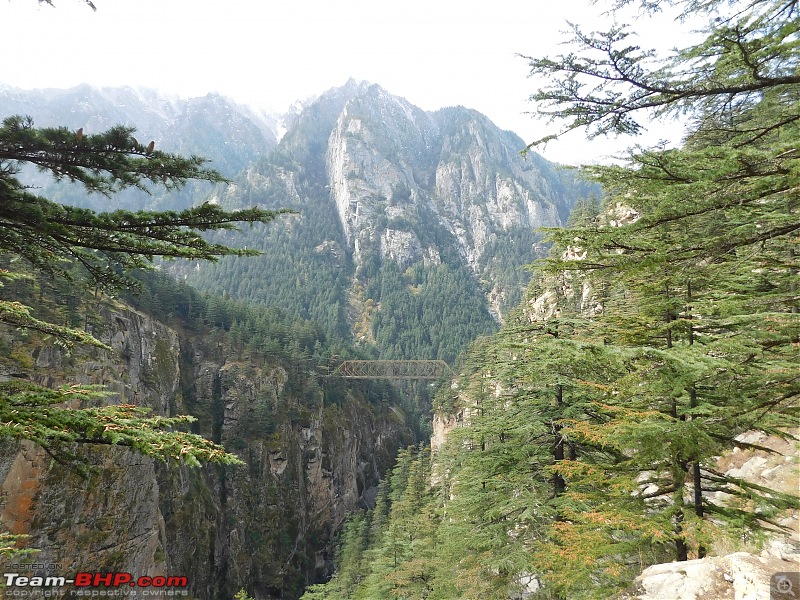
we crossed this bridge

with my mother
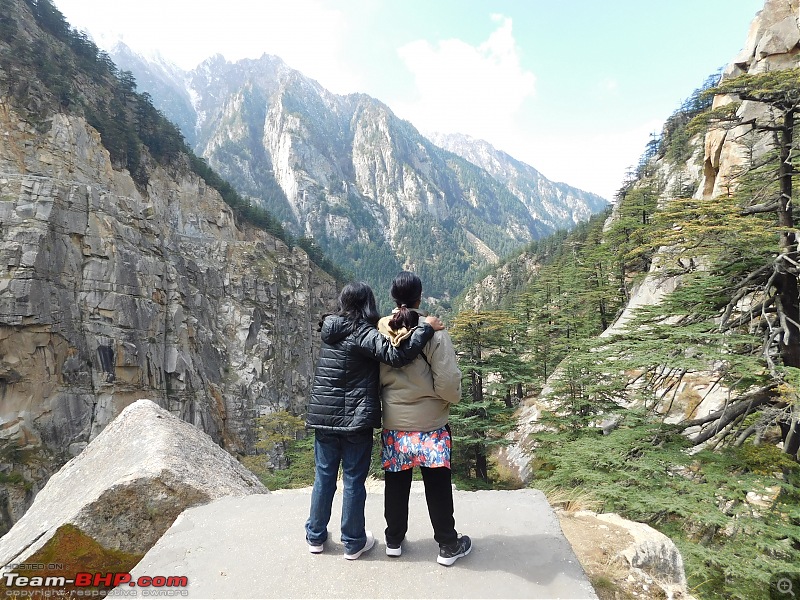
buddies
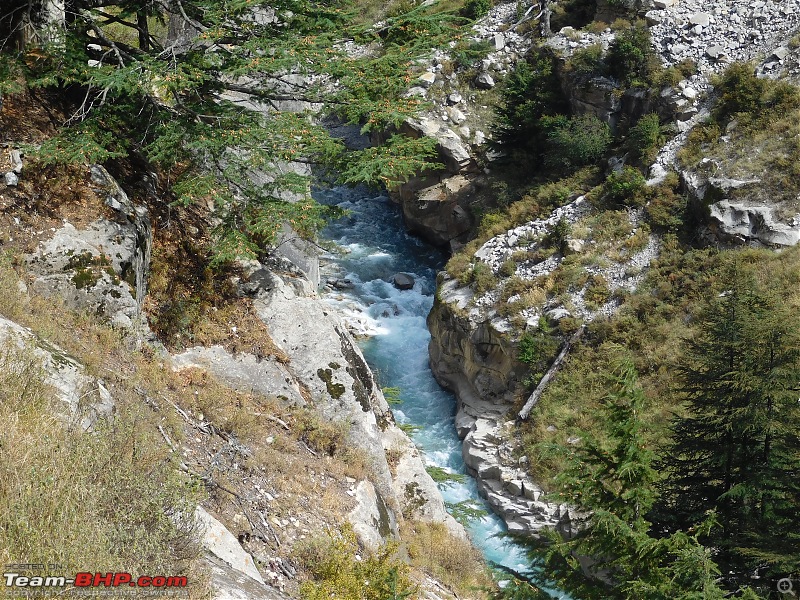
like a river of peppermint
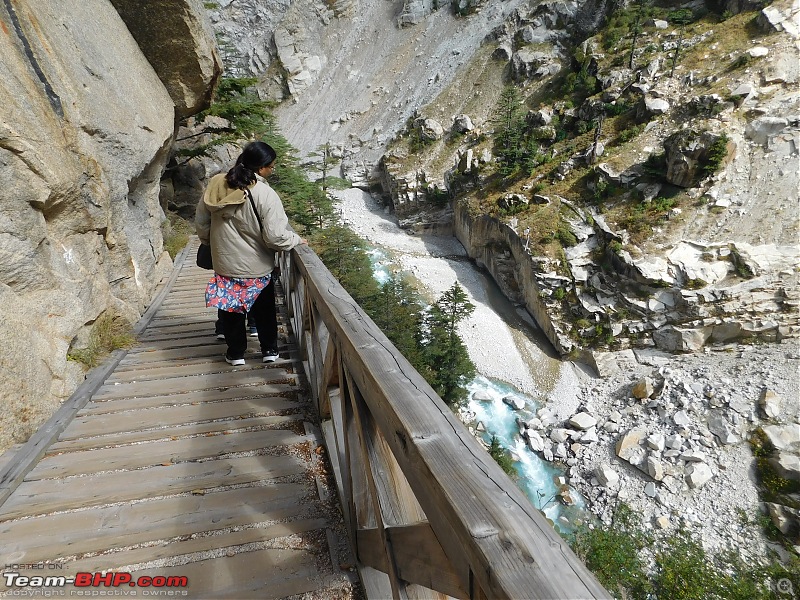
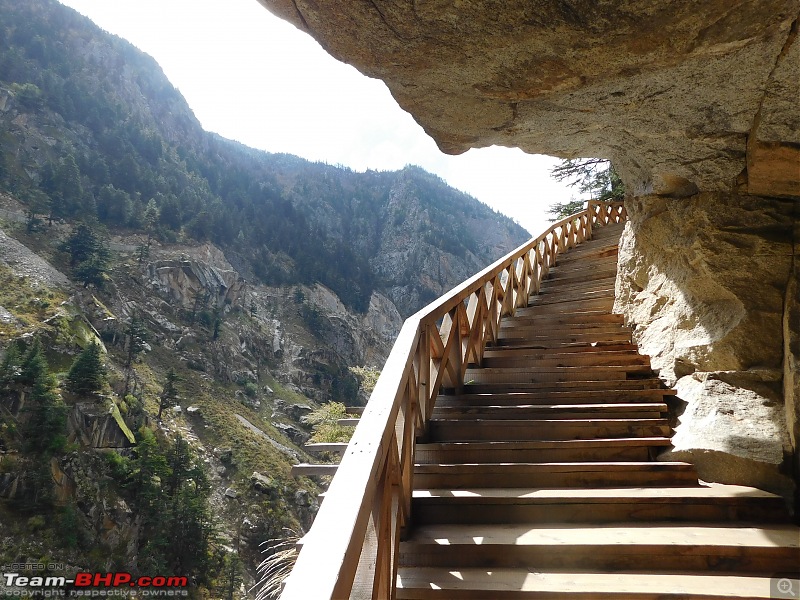
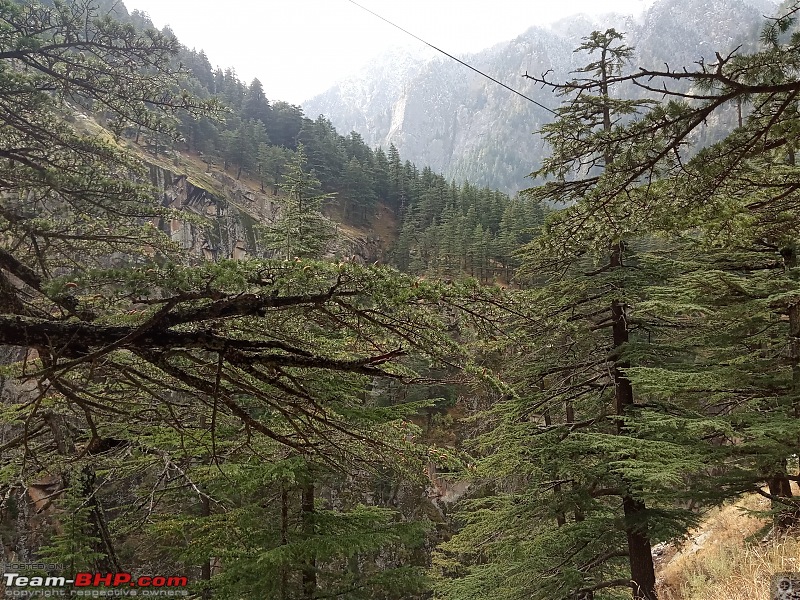
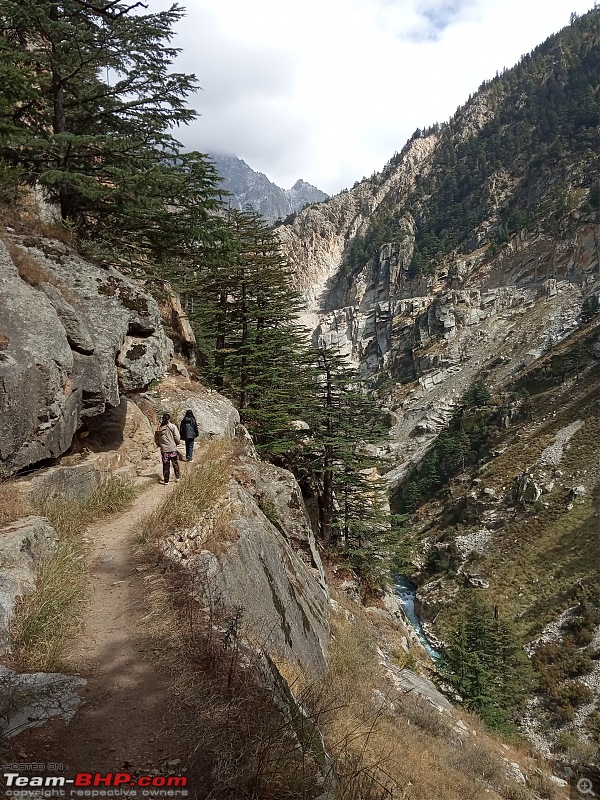
pic credit, my dad!
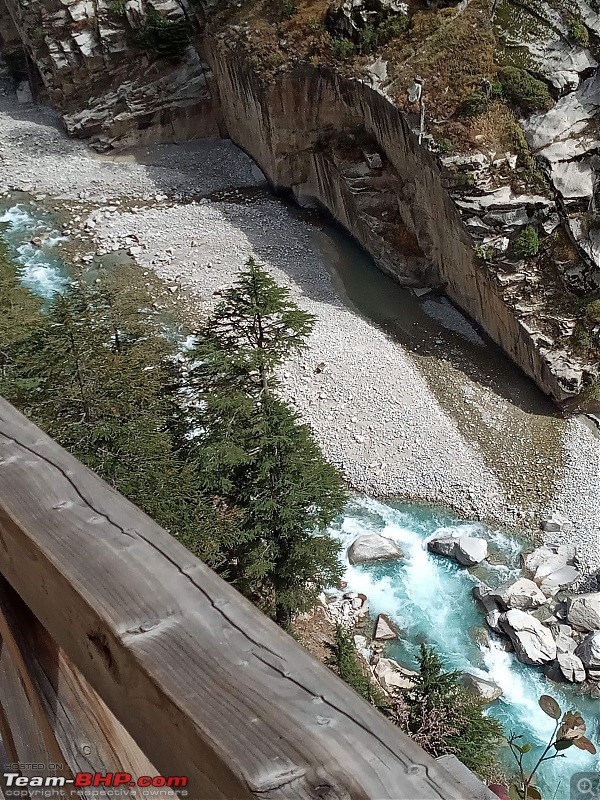
gives you a sense of the height
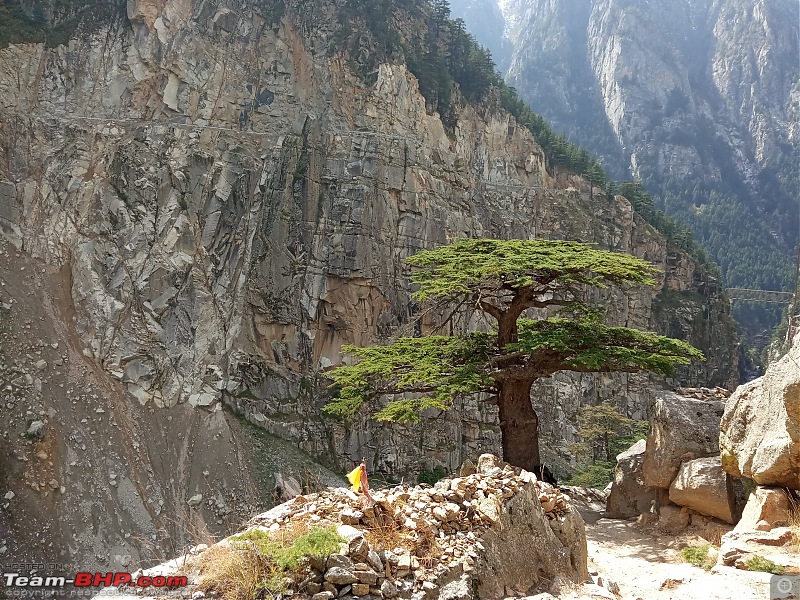
a solitary tree

walk like an Egyptian!
Day 7 - Harsil to Tilwara
We got up early to catch the sunrise, but the weather played spoilsport. The weather was playing hide and seek with rains almost everyday in the afternoon. I almost forgot to mention that I am an avid camper, well a tent enthusiast anyway! When the trip was being planned, I coaxed my dad to buy a tent from Decatholon with the hope that we would be able to make camp somewhere in the Himalayas. The previous day, while on our way back to Harsil from Gangotri, we spotted the helipad by the river and my dad suggested that we set up the tent and spend some time there. While we were setting up the tent, the weather turned gloomy without warning and the wind was gusting with great gusto! Dear reader, if you have even the basic knowledge of tents, you would be able to guess how our little effort at camping turned out: we just managed to set up the poles and the inner canopy and my mom and I spreadeagled ourselves inside so that poor dad had some chance of securing the poles. In the end, we just about managed to bundle everything in the back of the car before the fierce wind took the tent into the river. And the back of the car is where the tent stayed until the end of our trip. Lesson learned, camping isn't as easy as it looks on YT videos!
Back to our story, we realized that there was no point hanging around Harsil as everything was enveloped in fog and mist, so we set sail towards Tilwara. Just outside Harsil, the weather started clearing as the sun was about to come up and we were rewarded with some really jaw dropping sunrises with the peaks turning molten gold. What a sight it was, perhaps the mountains meant to reveal her bewitching side to us. The rest of the day was just mostly driving with my dad putting pedal to the metal in those twisty mountain roads. If I was the selfie type, I could have shared clicks of my face turning green; I just about managed the stretch without throwing up!
Tilwara is a serene little town nestled at 1600 metres above sea level. It borders the shores of the river Mandakini; which cuts through a valley. We found a nice hotel owned by the government with a path leading down right to the gurgling river. I will tell you more about it a little later, dear reader, so stick around!

outside the Harsil homestay
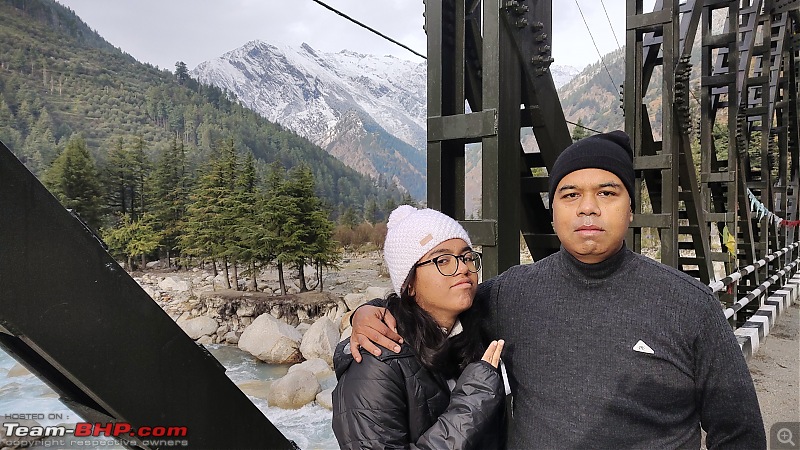
with my dad, the man behind the wheel and BHPian Hothatchaway
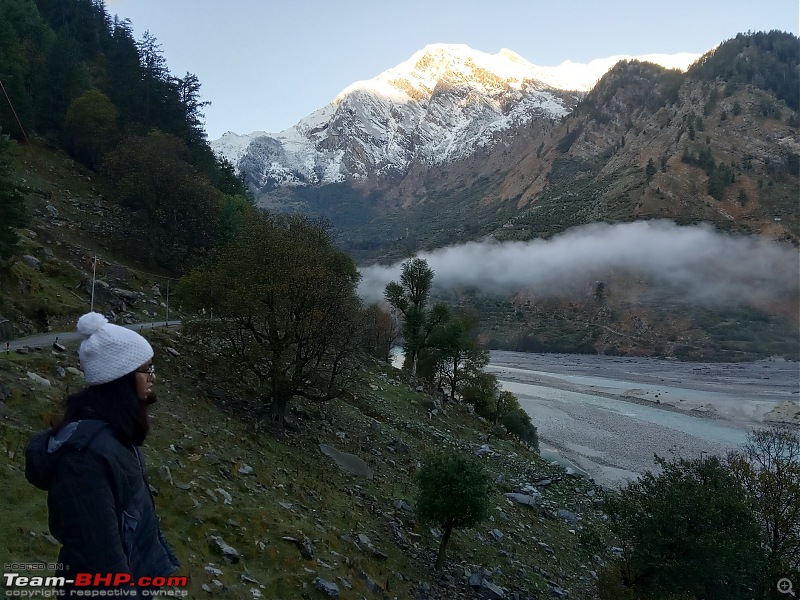
I was speechless
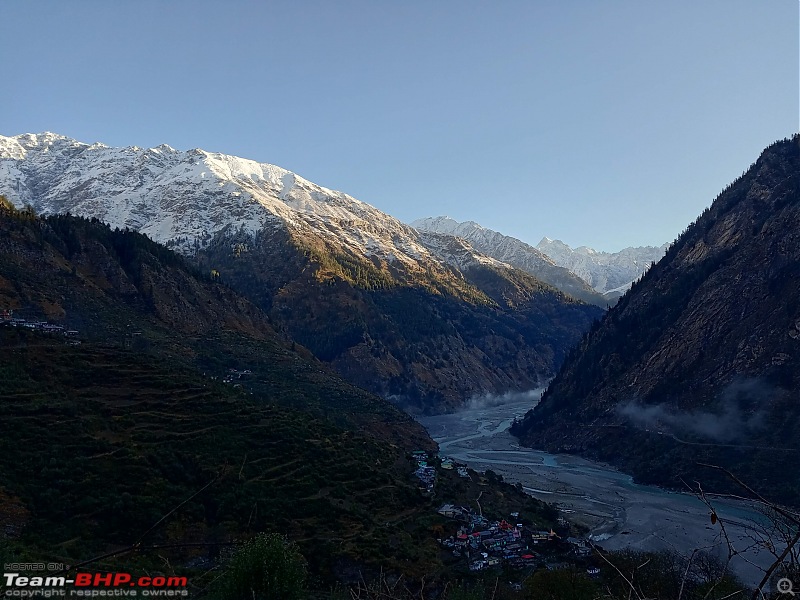
mesmerizing
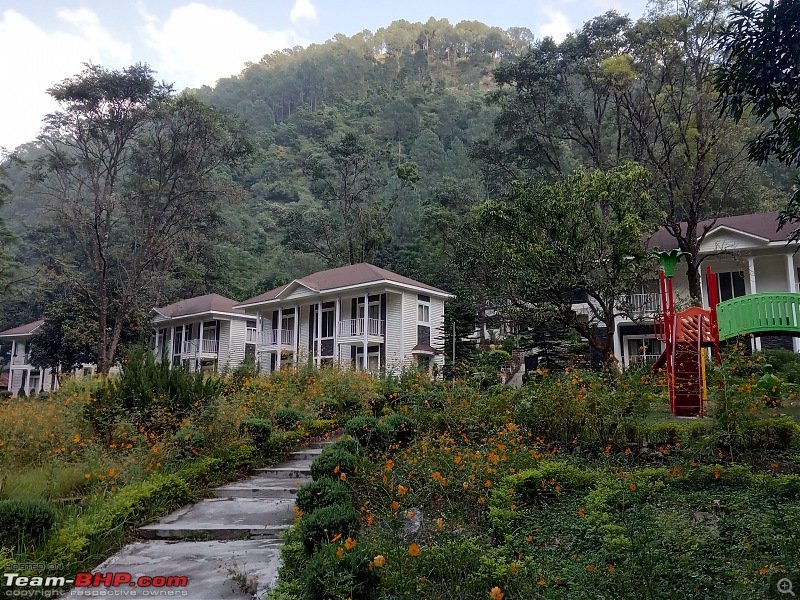
Our Tilwara hotel
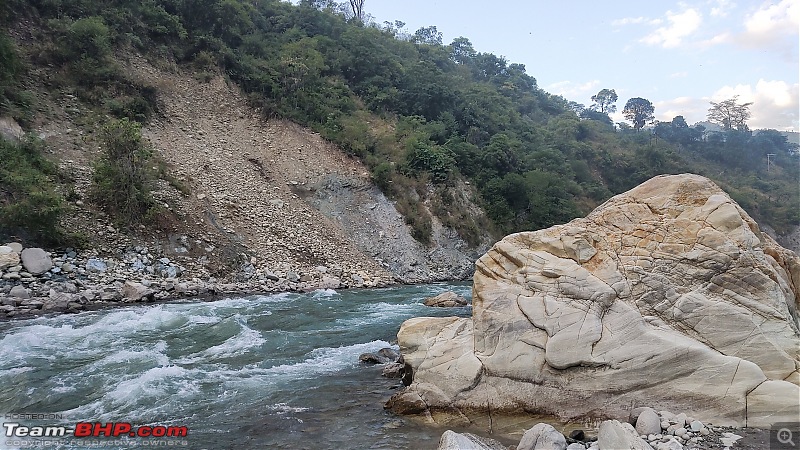
The gushing Mandakini
Day 8 - A visit to Chopta
I don't think mini-Switzerland is the right name for this surreal valley. Not that I have ever been to Switzerland, but I believe that this place has such a unique and quaint charm that it doesn't need to be likened to any other place in the world. Meadows after meadows of sweet green grass, evergreen forests of wise old pines and oaks, bubbling brooks of pure, crystal-clear water, and most of all, the snowy Himalayas at arm's length! what more could one want? This place is a natures lover's high. My dad chose a shorter route to Chopta which wound through a steep pass. We also gave a ride to a couple of local ladies who were hitch hiking and it was such a nice experience learning more about the place from the people who live there. We spotted some delectable looking birds with long tails as the route went through dense forests and we stopped more than once to just listen to the deafening roar of absolute, pin drop silence!
After reaching Chopta, we found a secluded spot and decided to enjoy a delicious orange in one of the forests. When I was a little younger and hadn't traveled as much, I used to dream of babbling brooks in the English countryside or famous forests by the Rockies, thanks to the books I read and the movies that I had seen. But by exploring India a bit more, I have learnt as many others have, that I don't need to go any further than the diamond shaped borders of India. Be it to find peace, or to be amazed by nature, or to educate oneself, India has it all. This is why I feel so lucky to be Indian, because anything one could want is within reach.
Coming back to our trip. There were many terrace farms everywhere (once upon a time I used to imagine people building a whole farm, cowshed and all, entirely on their roof! now I know better ;P) and a woman carrying a heavy load of grass was a common sight. An interesting piece of Himalayan and north-eastern culture is that the women are the dominant members of the family. They are the shop keepers, head of the family, they do a lot of the labor in farming, and they do the shopping. I wonder how that came about. Reverse psychology?
After that we drove back to our hotel. This was GMVN (Garhwal Manadal Vikas Nigam) property. You go down the road and there is a barely noticeable signboard which indicates the hotel is down a hairpin bend. So we almost missed it! But lo and behold, there is a beautifully paved parking space, and the rooms are extensive. There are perfectly manicured gardens, a park, and also a glass sitting room with a view of the river. The best part is, a rough path is build down to the river. But remember, if you happen to come here, get rid of your fear of bees or flying beetles! The shore was full of them. Also, when we came the river was shallow, and there was a distance of tricky stoves which covered the beach. I almost fell over the stoves while trying to swat a beetle. After this traumatic experience, I decided to stay in the ice cold water which was the only place the critters wouldn't go.
The water was very clear and very refreshing. The river was a little flatter here, but the current was so strong that we couldn't see right through it. There were slippery boulders and the stones were so beautiful. A thousand different designs and colors! We chilled with jeera soda and watched the sun set. People pay for therapy, but I find it in the hills.
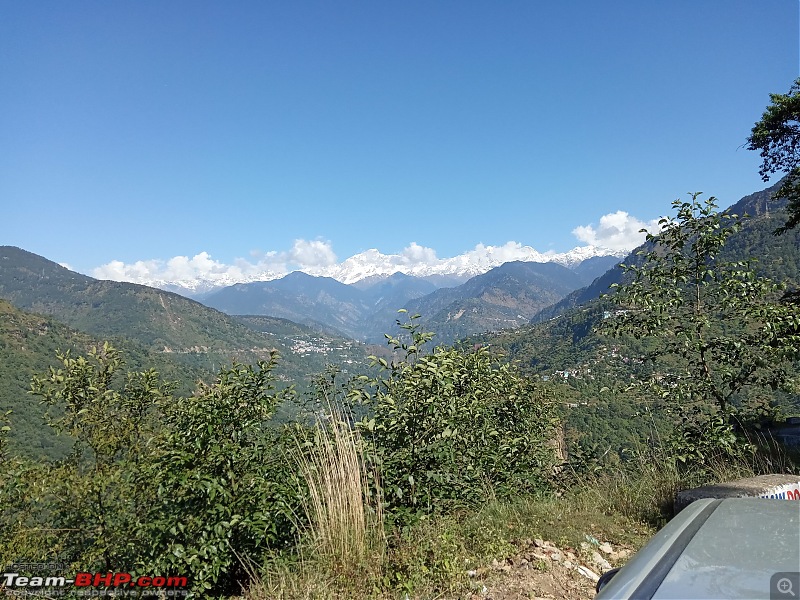
Choukhamba
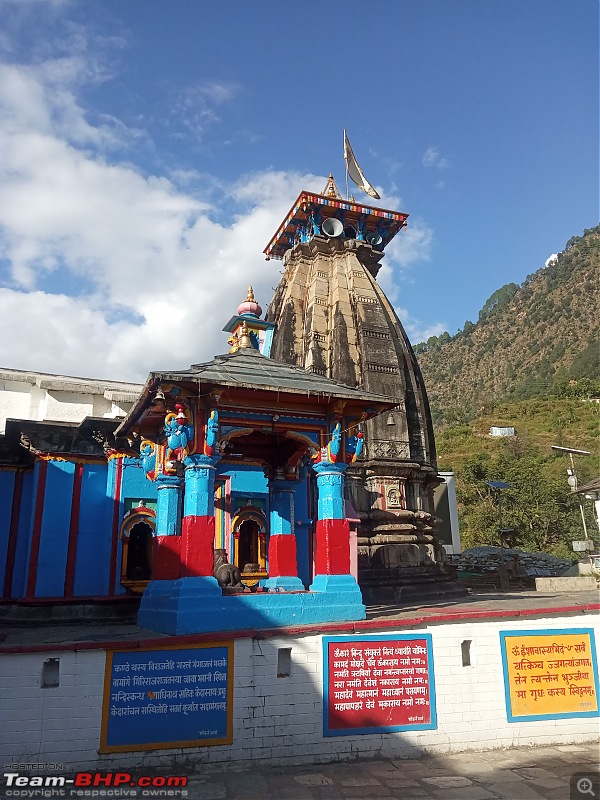
The pretty temple at Ukhimath

The meadows
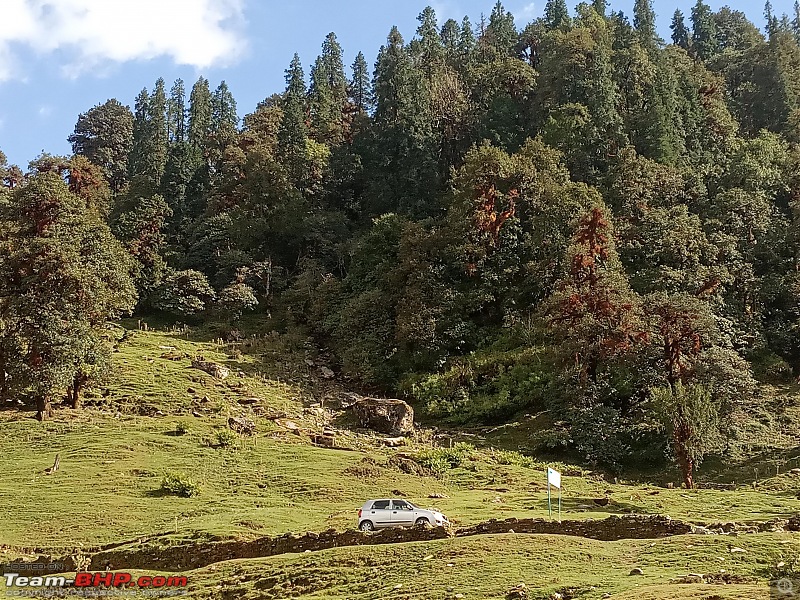
Our brave Alto
With that, I will move on to the next phase of our trip, where we climb really high. So stick around!
Auli is just like one of those small villages where people farm, they live simple lives with few others, and are surrounded by mountains. It is thirteen kms or so from Joshimath, which had earnt a place in the newspapers for its sinking roads and crumbling houses. And we were to spend the night here at 3050 meters high! It took half a day to get to Auli. Also, this was the only place where a river did not accompany us. The road was like a jalebi; it twisted and turned just like the golden, sticky sweet mithai. Sappy brown hills strode away into the distance, while screes of grey stone glittered in the sun. Jagged rock faces rose on one side.
And finally, we reached our home for two nights. The place was next to an ITBP camp and had several tents (!) I was very excited when I saw a big-eyed dog looking at me. I forgot to mention my fondness for mountain canines. You will see them snuggled at the steps or howling out at the sky from the railing. I get this incredible urge to hug them, with their big fluffy fur and their wise little faces! This dog happened to be wounded as I saw it tear up at my little pat on it's neck. I asked the proprietor, Mr. Negi, about it and he told me that it had been in a fight with the other neighborhood dogs, trying to protect the garden from them. The garden was a nice lawn with potted plants around it, just then a goat was rooting around the leaves. The dog was on its feet in a second and on its way to shoo it off. How loyal can these creatures be?
Our tent was barely a tent for the luxurious feel it gave us. It was a Swiss tent, with a metal structure built over and around it for when it snows. I felt like a queen on one of her journeys, with the beautiful wooden bed and the cozy linen. But the thing I loved most was the little meadow right beside the property. From this quiet place I could get a phenomenal view of the mountain ranges, close and far. Although the mountains were shy and barely peeped out of the cloud cover, I found the sight divine. Any sight of a mountain is definitely worth stopping for a moment and admiring. It is a blessing from the gods to look at the Himalayan peaks, completely unobstructed, out in the open. But somehow, I love it when the fog or clouds grace and clothe the mountains; it gives them this mystical, subdued yet powerful aura, much like the purdah of the Mughal royal women.

bucolic beauty - our Auli homestay
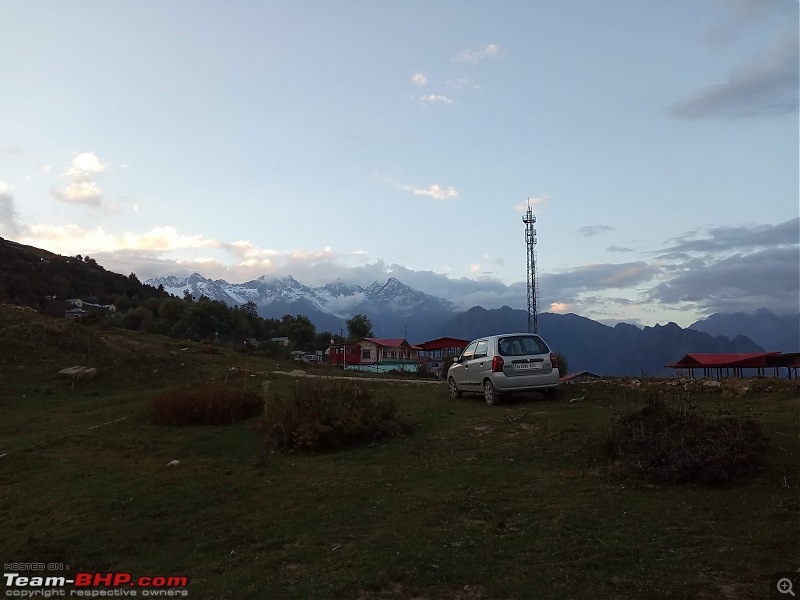
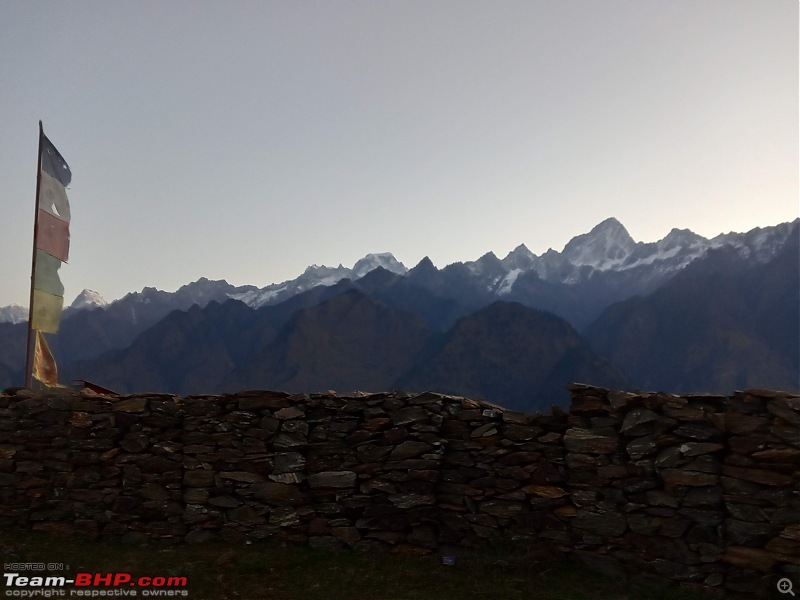
nirvana
Day 10 - Trip to Badrinath and The Flying Chair
So it truly made my day to stand in the out on the meadow, the exhilarating mountain breeze marking dawn in the Himalayas. The sun could not be seen, but it made its mark anyway. One of the snow caps caught the light. It looked as if someone had taken a whole lot of sunshine, put it in a tumbler and was pouring it all on that peak. In seconds the icy blue turned to a warm yellow light. If you haven't seen a Himalayan peak at the break of dawn, you are missing something very special in your life.
Let's get back on the road. The first order of the day was to drive to Badrinath and also Mana, the last Indian village. The road played hide and seek as good stretches suddenly gave way to loose gravel with the surrounding cliff sides threatening to rain boulders down on us. We did a quick darshan of the temple and drank some hot, saffron flavored milk from the many food vendors lining the lane to the sacred place. Next we posed for some photos at Mana, which was more crowded than we would have liked. The mountains here were treeless and dry, but they had this hypnotizing effect on me. According to my dad, this was how some parts of Himachal looked. I made up my mind to go to Himachal one day. My dad wanted to drive further onto the pass but we were shooed away by the military as we did not have permission! On our way back to Auli, we passed the starting point of the famous Valley of Flowers and Hemkund Sahib treks. I made another mental note to be back someday to explore these places on foot.
Back at Auli late in the afternoon, we drove up for a couple of kilometres past our homestay to reach the GMVN property. Here was the chairlift taking us to the starting point of the famous trek, Gorson Bugyal. Bugyal is the Garhwali name for meadow. So this place, Gorson Bugyal, was actually the Meadow of Gorson. So we hopped on the flying chair and zoomed (actually slid) down the way to the starting of the trek. It was a whole new experience!
After reaching the end, which was quite higher, I could literally hear the wind whistling. So that was what they were talking about! There was a meadow, an artificial and lake, and the start of the trek. At the end of this trek would come Gorson Bugyal. Foggy hills dropped away while buggy drivers crept up from behind us. ''Sir, it will be bahuth achha, buggy trip, very nice'' and more along those lines. Me and sir and madam together ignored them.
It was quite late to start the trek now all the way to Gorson Bugyal so dad and I decided to hike up a little bit, explore the place and come back. In some time, the path was thick with trees and I felt like staying there for the night. We came to a glade from where we could see the icy peaks. Tempting red berries made this world a bit more fairy like. We saw what looked like an abandoned warehouse with a tin shed and it was a scene straight out of a first person video game setting. We could see the lake below from where we had climbed up, with the towering peaks as the backdrop. I went to have a chat with some nearby grazing cows to discuss the latest interest rates and the economic state of India. They were so knowledgeable that they could write a book about it. Never judge an animal by its species! Dad and I sat on some tree stumps at the meadow and soaked in the silence. We never made it to Gorson Bugyal but this wasn't bad at all!
We took the ropeway back and saw a gate on the other side, which led to a Hanuman mandir. Three sides of the mandir had guardrails which made for a kind of a viewing gallery and we could see the snow capped peaks in all their glory! I forgot to mention Mt Kamet, the highest peak in Garhwal. It looks like a pyramid, solid and burly and what a sight it is at dawn, with the sunlight reflecting off its snowy back. I again met some of my furry friends at the mandir, they somehow knew a dear friend had come visiting from faraway!
We went back to our homestay and the thing is, one could happily spend a whole trip even without even going to the nearby popular tourist attractions. To actually enjoy the Himalayas, I have to spend time admiring them, contemplating them. Just looking at them for ten or fifteen minutes is not enough. You just cannot admire them fully without spending enough time observing them.
So this is how I spent the evening, with the beautiful sound of the wind and the bells around the cattle's necks. The jagged Nandadevi, and the strong and uncut pyramid of the Kamet were all mine that day. Or was it the other way round?

the muscular Mt Kamet
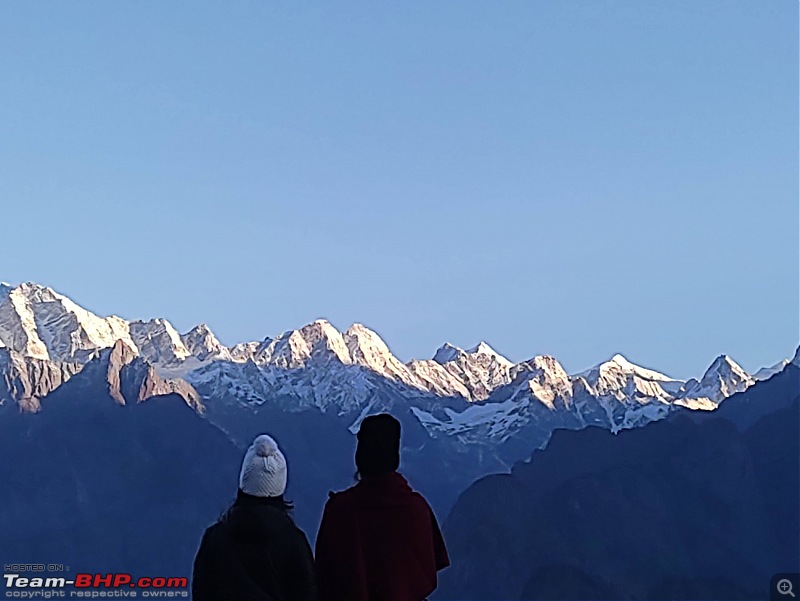
Moment with the mountains and my mum
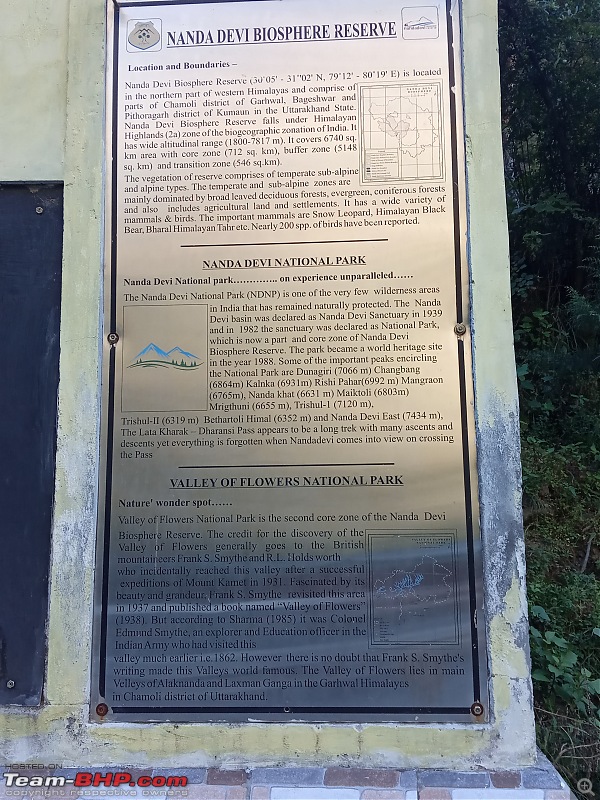
the rich ecosystem
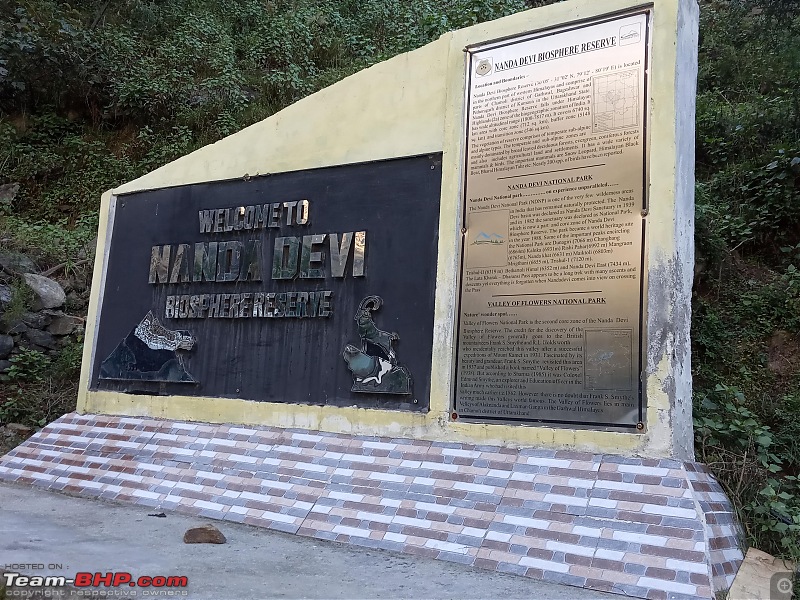

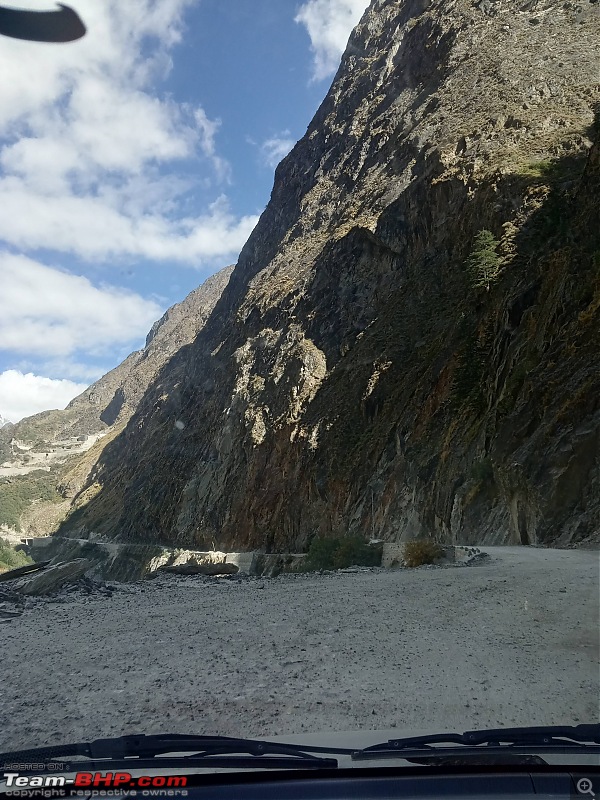
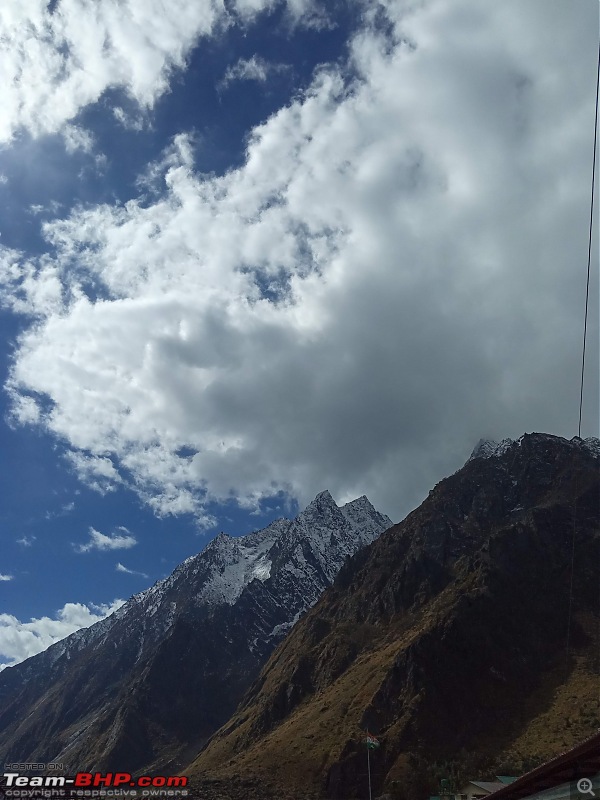
Mt Neelkanth, I believe
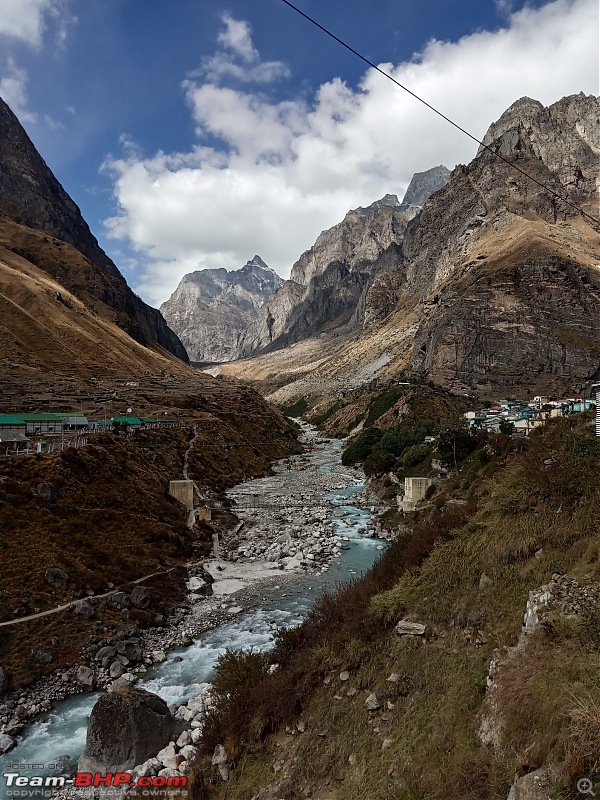
Mana from a distance

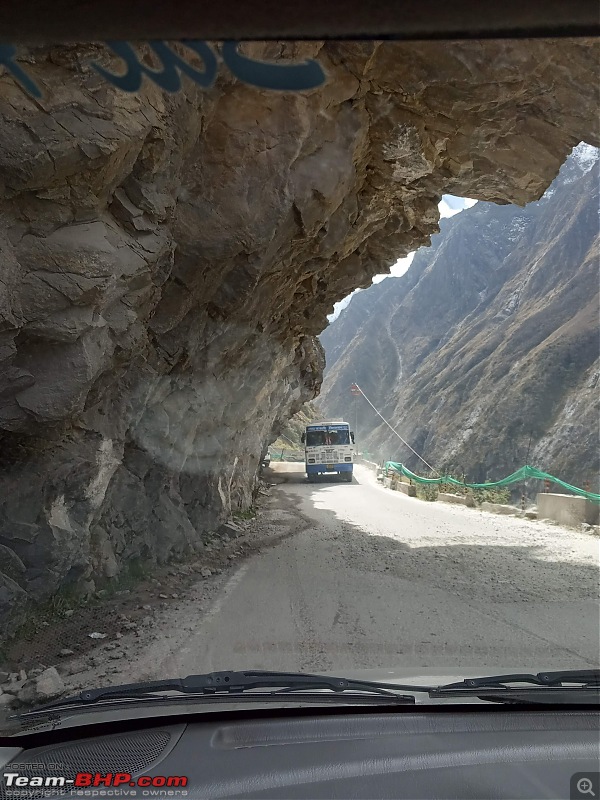
face off
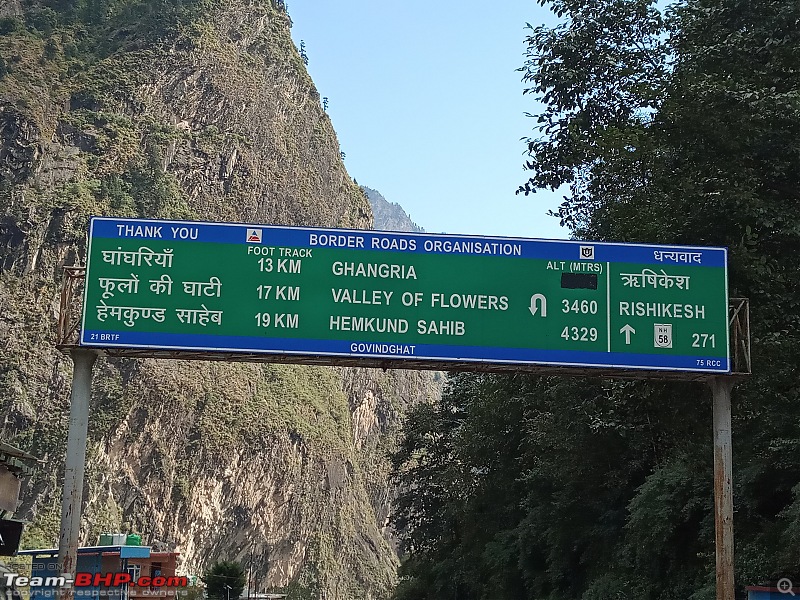
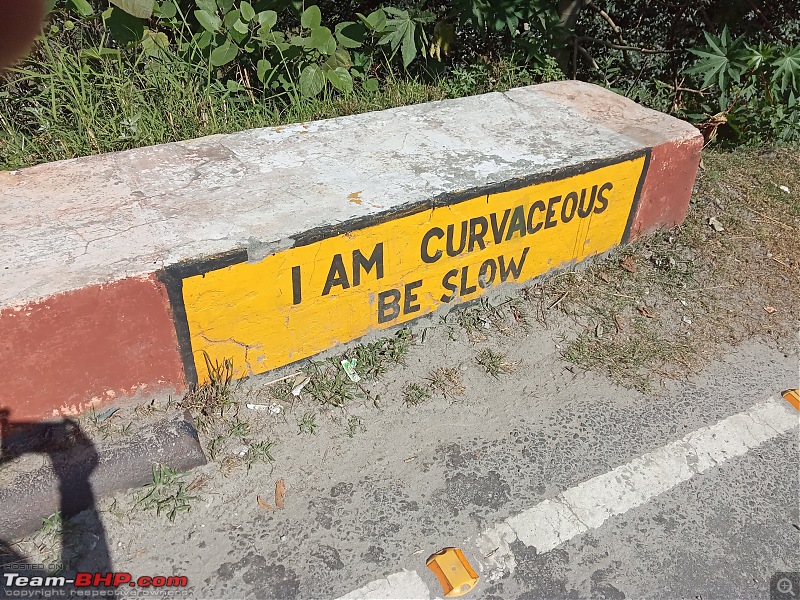
BRO got jokes
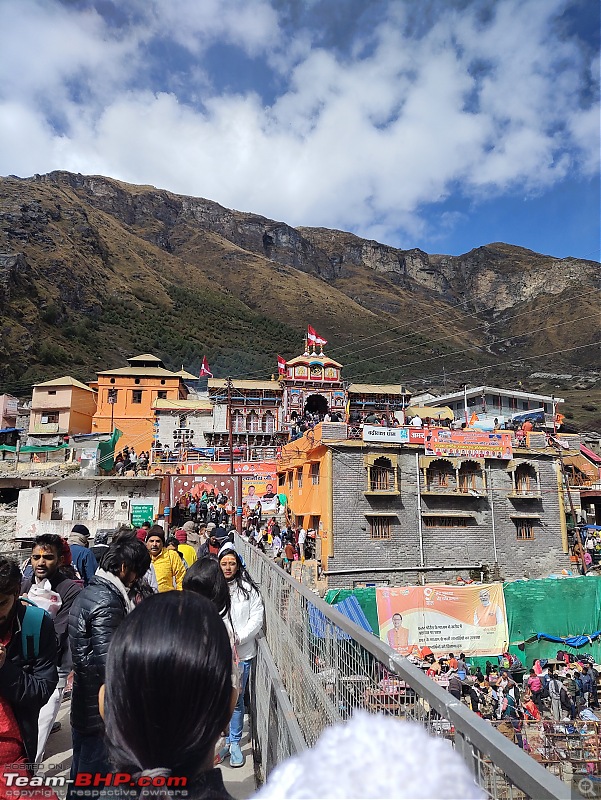
Badrinath
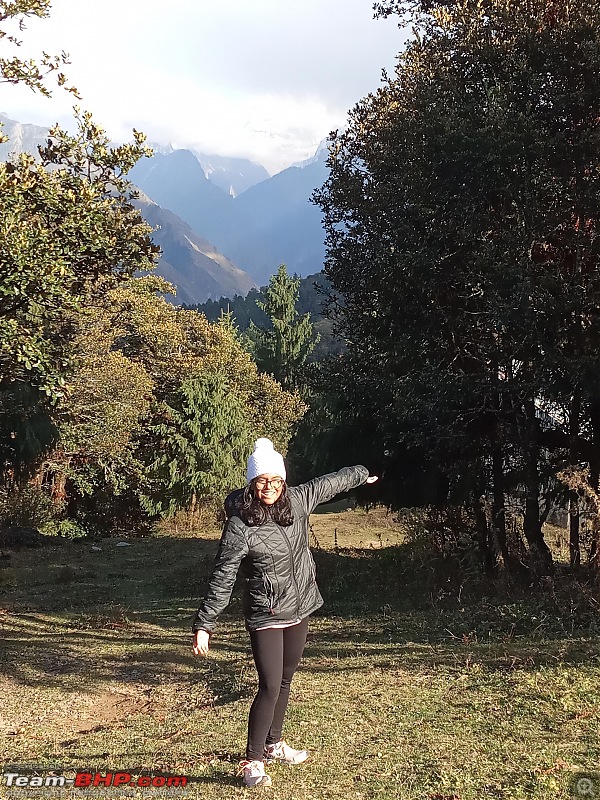
The glade on the way to Gorson Bugyal
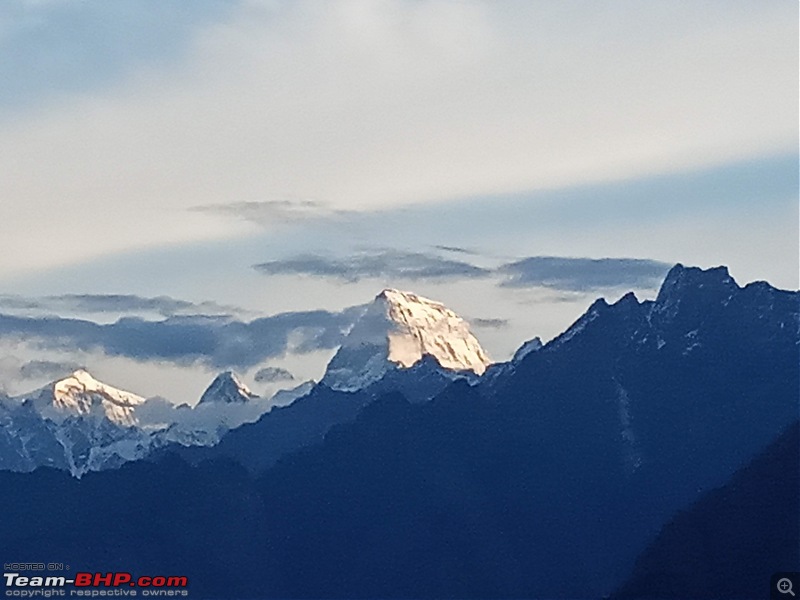
Kamet behind the clouds
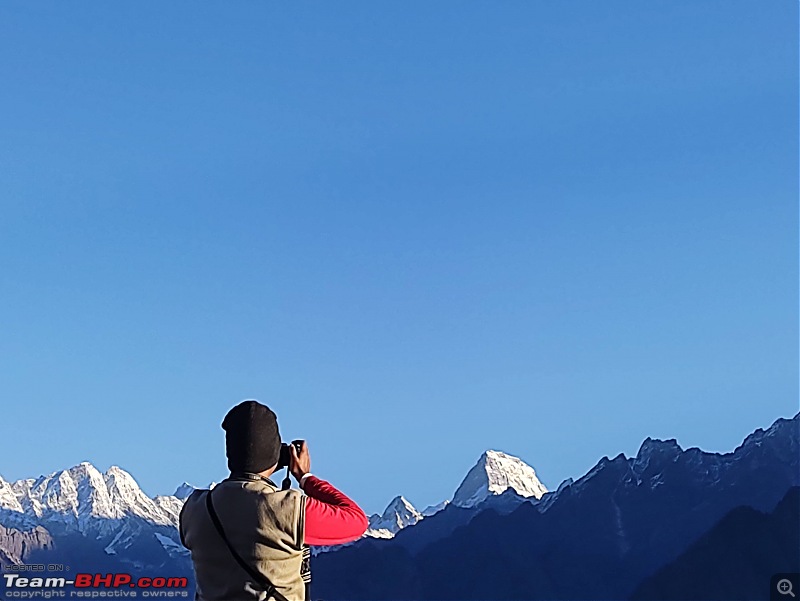
My dad is like a child when in the mountains!
Day 11 - Auli to Nausea to Kausani
Another treacherous overhang. The road was really more vomit inducing than a rollercoaster ride - hairpin bend after hairpin bend - enough to supply ten hairdressers! I'm sorry if you find this revolting, but it's an important part of my skillset - I can control vomit. I can go hours feeling nauseous without turning a hair. It's true. If there are any backseat travelers out there reading this, I understand you. It may be really tough sometimes and others may not know why you're keeping it in, but there is no better feeling then the feeling of having cleared the vat inside of you!
Ten hours later and we were at Blossom Hideaway, Kausani - and a true hideaway it was! You get off the main road, you see the signboards, you see a path leading down from there, and a steep, winding path down, you will find the hotel. But the place was a true gem. The building was sprawling, the rooms were large yet cosy with thick beds and blankets and from the terrace you can see the full range of the greatest peaks - Kamet, Trishul, Nandadevi, Panchachuli, Chaukhamba all at once! After dad had checked us in, we settled into the restaurant on the terrace with the sun setting behind the gorgeous mountains. The pink hue of the sky at dusk, the soft orange glow that the setting sun leaves on the peaks on his way down and the cool crisp breeze promising more cold to quickly follow. Isn't this why we come to the Himalayas?!
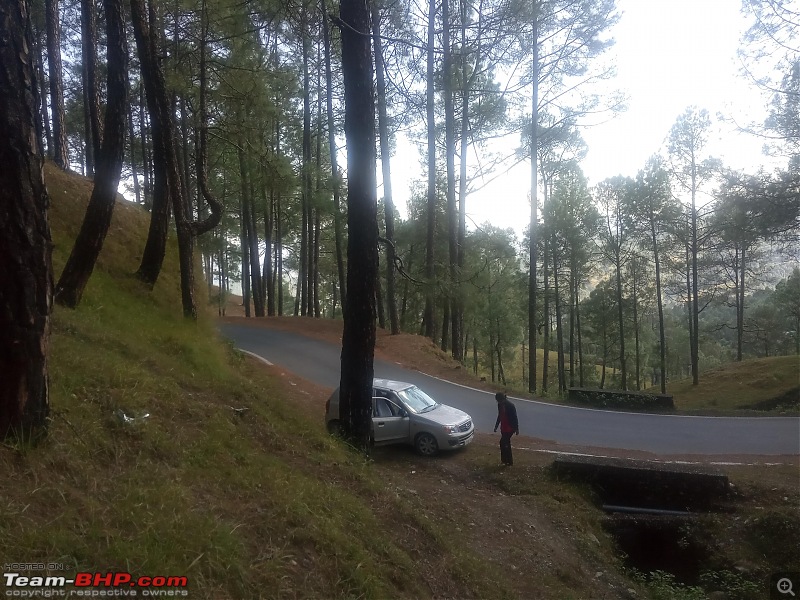
interlude in a pine forest on the way to Kausani

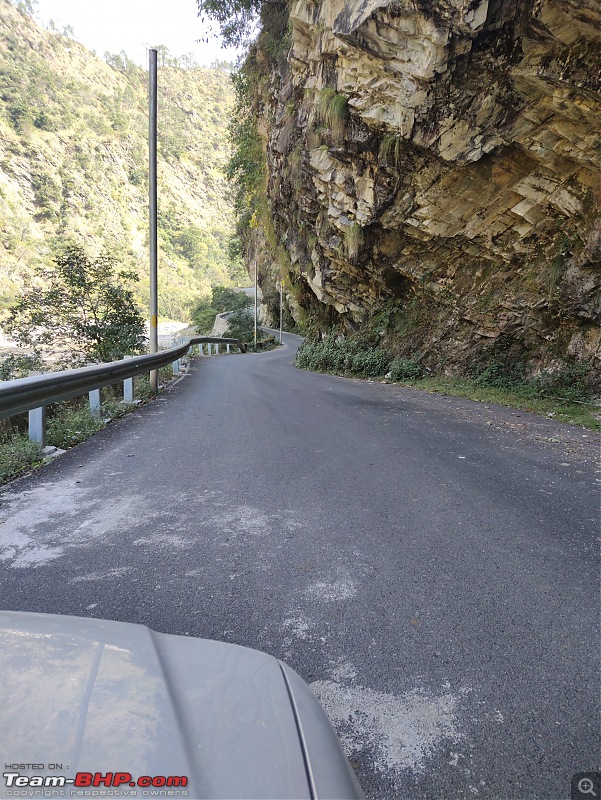
the road bares its claws
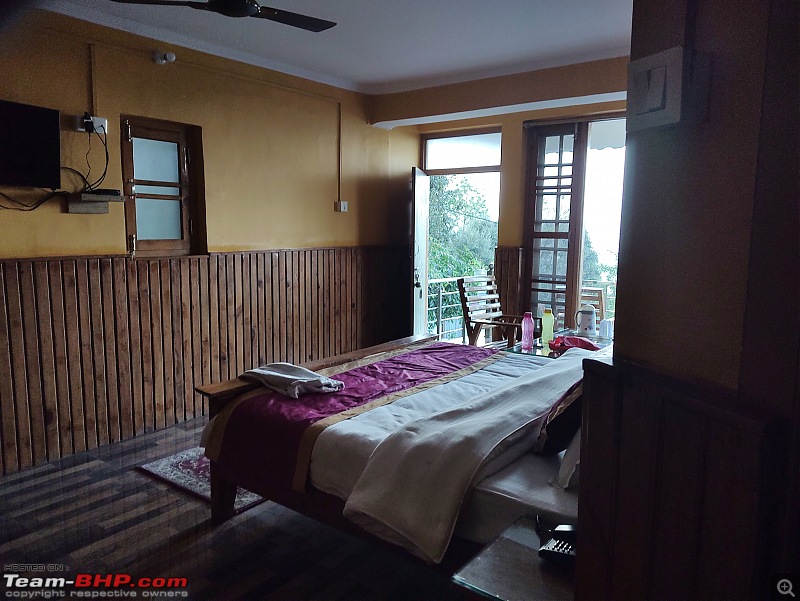
Blossom hideaway - it was truly a hidden gem
Day 12 - Adieu, Himalayas! Kausani to Lucknow
Just the before the sun comes out in the Himalayas is an eventful time. The birds take up their orchestra practice, the breeze slides past in good morn, and the summits prepare to look gorgeous. Dad did not want us to miss the sunrise before we return to the plains. When he pushed me out of dreamland, it was still dark and he was all ready and dressed! I do not know how the man does it; every morning since we have been here in the mountains, he was up before the crack of dawn, brushed, shaved and dressed for battle. So that he does not miss the perfect mountain sunrise. All this usually after a long stint behind the wheel the day before and another one to follow that day. He is not human I tell you!! And the worst part is, he expects the same from me!!! The day is not far when me makes me drive the car underage!!!
Anyways, back to our story, we quickly got dressed and rushed to the terrance. But alas, the law of averages was right behind us. After catching some glorious sunrises, it was a cloudy morning at Kausani. We stomped our feet for an hour keeping ourselves warm and hoping for a glimpse of the golden peaks but they were partially hidden. Being seasoned travelers, we ordered for a pot of tea, packed and prepared for our trip back to the plains. It was going to be a long day and we were leaving the Himalayas for this time, but we still had another delight to look forward to! The montains did not want us to leave with a long face, so just as we were making our way down from Kausani, we got a lovely view of the Panchachuli range and Mt Nanda Devi. My dad wanted to make things a little more adventurous, so he missed a turn at the intersection and took us some 20 kms back the way we came from when we drove to Kausani
 So engrossed he was with the gorgeous view. We drove an extra 40 kms, but the good mood lingered as we went through the scenic garrison town of Ranikhet where we shopped for handicrafts and also found a Durga Pujo pandal!
So engrossed he was with the gorgeous view. We drove an extra 40 kms, but the good mood lingered as we went through the scenic garrison town of Ranikhet where we shopped for handicrafts and also found a Durga Pujo pandal!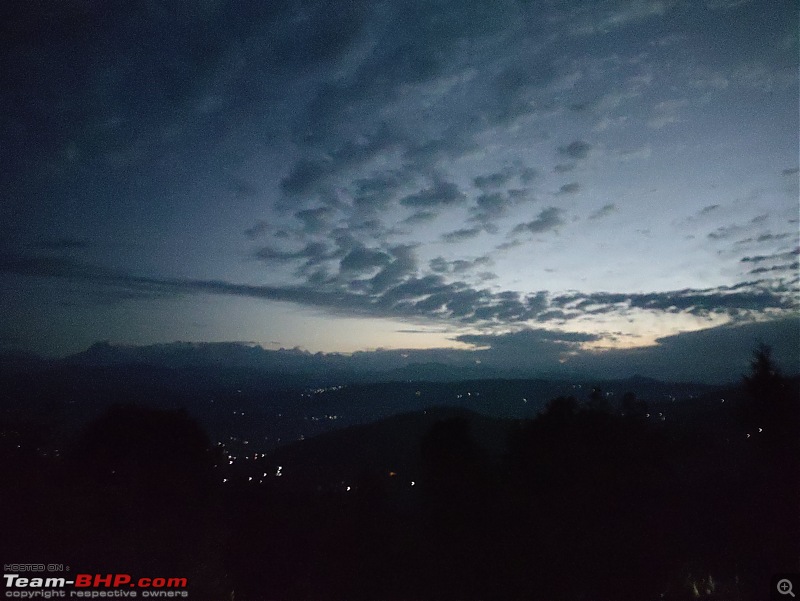
dad tried some night photography at Kausani
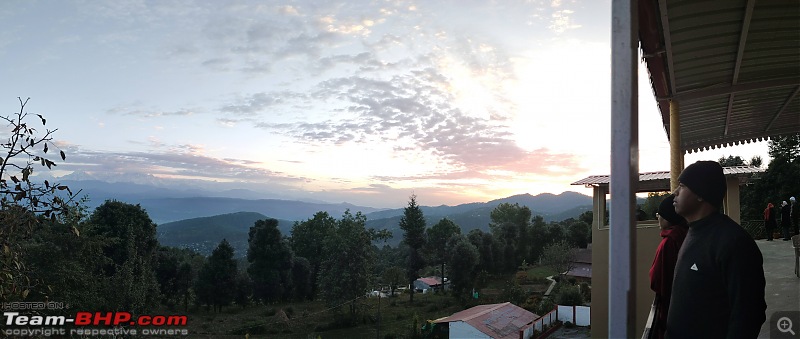
the clouds played spoilsport
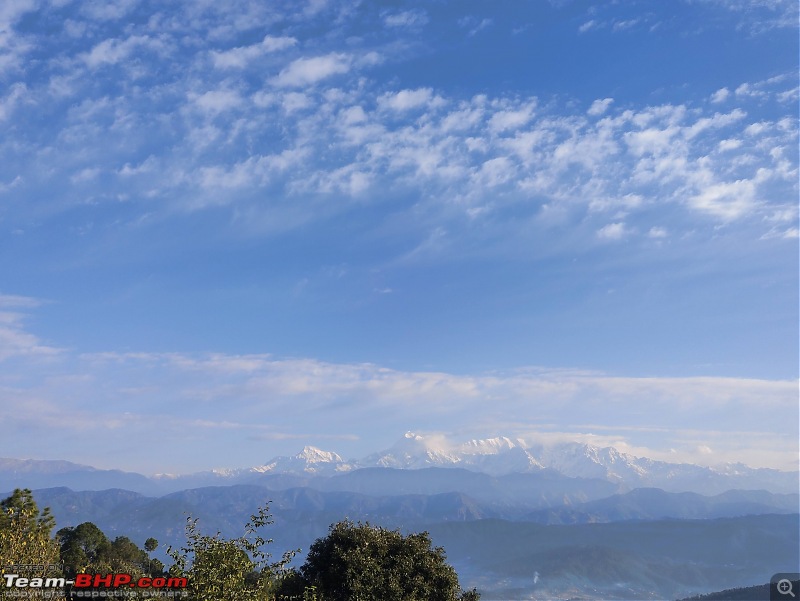
...but patience paid off
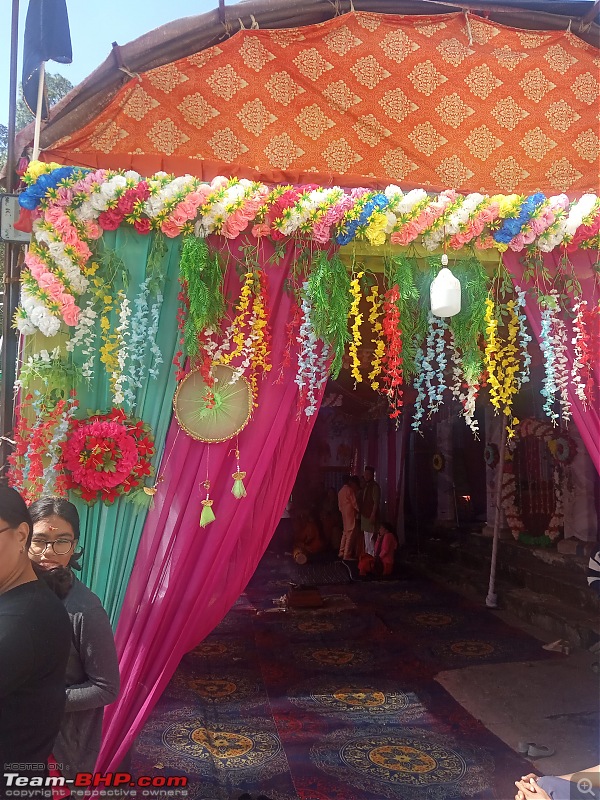
Durga pujo at Ranikhet
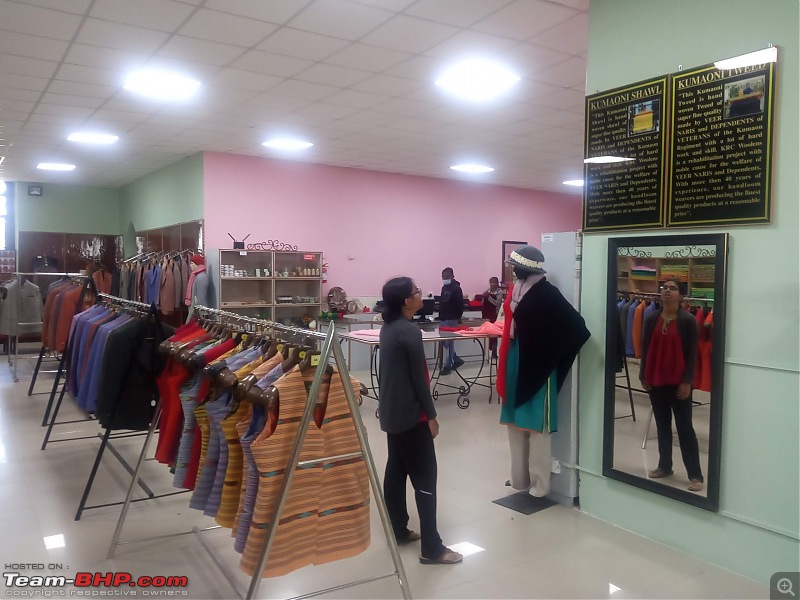
The handicraft musuem and store
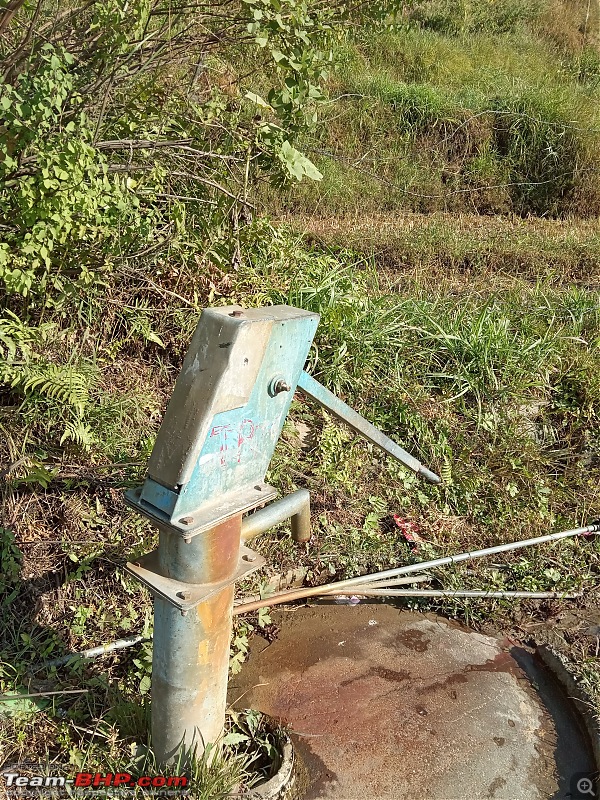
we saw plenty of these handpumps in Kumaon, most seemed dry and the local people do not use them much. I think they were more of showpieces and to add some colour contrast

We thoughts of taking a detour to Nainital to visit the Jim Corbett museum, after all, he was my inspiration for this trip. My parents felt it would add 3-4 hours to the drive and I decided that I wanted to remain vomit free while we leave the mountains for this trip. We stopped for some mutton rice at the foothills and I saw many tourist type drivers with loud music rushing up the mountains. We left the lovely state of Uttarakhand as it was getting dark and my dad doubled down on getting us to the next leg of our trip. It was going to be the city of Nawabs and kebabs! So stick around.
After hopping from hotel to hotel for half an hour, my parents finally settled for the Gomti Hotel, UPTDC. Just like it's two other siblings, this hotel had a really nice lawn to sit and enjoy a nice mug of... soda! The room was also super comfy, but like it's twin in Jhansi, it was a wise old building. But I didn't notice - after a shower I had a mini coma! Goodnight

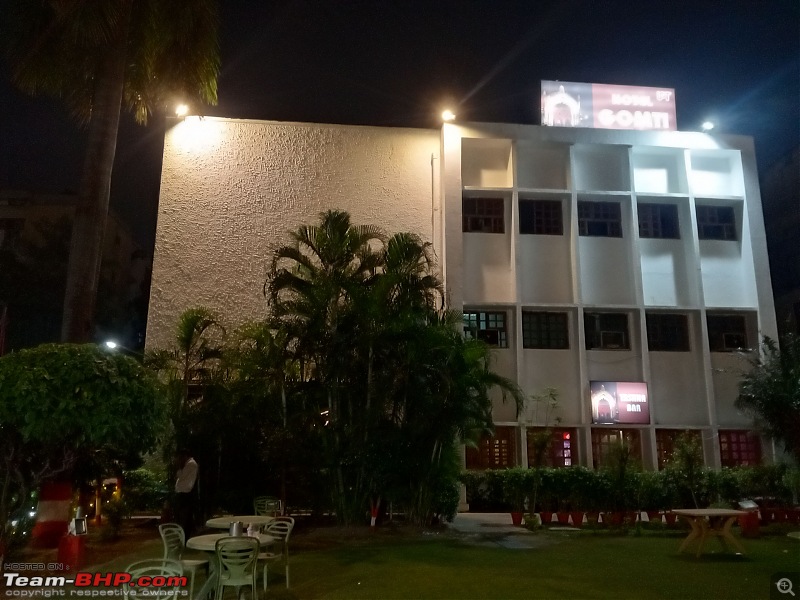
Hotel Gomti, Lucknow
Day 13 & 14 - Awadh, Imambaras, Chikankari and more!
A Dashami in Lucknow
Waking up was a slow process. Then I realized I was in Lucknow and rushed to put on my best clothes. I had some dalia and yummy alu parathas (with dahi) in the dining room of the hotel and was itching to get started. Hello, Lucknow!
Our first stop was at a pandal. It was Dashami, the last day of Durga Puja, and we wanted to start our day with Maa's blessings. As usual, my father had already woken up before daybreak and done a small tafrih (means sightseeing among others in urdu) He had found a community Durga Pujo, actually the oldest one, organized by the Young Bengalee association which was our first port of call for the day. Here, I saw the beautiful murti or idol of Durga. To her right was Lakshmi, with a bright and calm face just like the lotus in her hand, Saraswati, to Durga's left, had her swan matching her beauty. Ganesh completed the picture, with his slightly mischievous expression, along with Kartik, with his peacock. The four siblings flanked either side of Maa. Gracefully arched eyebrows, long and curly hair, a little smile playing on her lips - the idol inspired awe and admiration. The idol making here was a little different. The murtis were more doll like and their complexions more natural. I joined my hands in respect. Subho Dashami!
A breathing monument - The Residency
My grandad was born in Lucknow, so once when my dad was little he had taken him to the Residency - the sprawling relics of the once imposing British enclave, site of the first war of independence of 1857. Today my dad was taking me there, and he says it has the same impression it had on him as it did back then. An impressive structure, the Bailley gate, was the first to greet us at the residency. Although it was just a gate (as if any gate was just a gate at that time!) It had a unique look about it, especially with the little craters on the walls made by the shelling. This is the place where the attack of June, 1857 of the Sepoy Mutiny took place in Awadh, or Oudh as the British called it, present day Lucknow.
Dr Feyrer's house gave us an idea of British Indian homes in the mid eighteen hundreds. Meanwhile, the masjid, a little deeper into the residential complex gave us a glimpse of the beautiful mix of Islamic and European architecture. The Begum Kothi had a fascinating history of previous owners. Ruined courtyards and cobwebbed private rooms - each building told a story of it's own. Bullet wounds on the red bricks made each and every wall a breathing piece of history. Segments had broken off of the facades by cannon balls shot two centuries ago. Yet the whole place had the glamour and freshness of the residency Nawab Saadat Ali Khan would have completed in the late 1700's.
There was also a museum in the heart of the residential complex. It offered an impressive collection of lithographs, made right after the revolt of 1857. Lithography is an old process of printing using stone or metal to make a copy with the help of a chemical reaction. In this museum, there were lithographs (color and monochromatic) of paintings and sketches of the residency fresh after the attack. One framed piece which struck me the most was a watercolor of a billiards room. The cue balls and sticks left halfway through the game, an open book face down on the floor, fruits scattered around, broken wine glasses - and a wall torn open. They must have been taken entirely by surprise.
The museum also offered several letters to and from Sir Henry Lawrence, the Resident at the time, and the Governer General. Scripts from the Chief Commissioner's offices also highlighted the military and political aspects of the Mutiny.
Portraits and descriptions of the first freedom fighters of India were hung on the walls, mostly the native rulers such as Wajid Ali Shah, Rani Laxmibai, and others. The British had been here from the 1600's. It was only in the mid 1800's when the British tightened their grasp. And these rulers were the first to start the long, long struggle against British imperialism in India.
There was also a cemetery. I think this is the most important part of the Residency, for us to understand what happened. It is a common belief that the Mutiny happened because the grease on the cartridges of the soldiers' guns were made from cow and pig fat, which hurt the mostly Indian troops' beliefs. But it puzzled me to see tombstones of English children and young wives written on them. What could have sparked this intense anger among the soldiers which led them to take the lives of women and children? Is the cartridge grease story just a tip of the iceberg as to why the soldiers felt the way they did? Maybe we will never know.
The cemetery had such a touching feel. The important structures in the residency were well kept and the gardens well manicured, but in some of the places where the most damage was done, trees and weeds had come up and flavor the ruined aura.
Coming to the Residency has once more proven to me that textbooks give you an account of someone who was never close to being there. Going to a place, experiencing it, and soaking it in even for an hour or two - it's as good an eye-witness account as you can get.
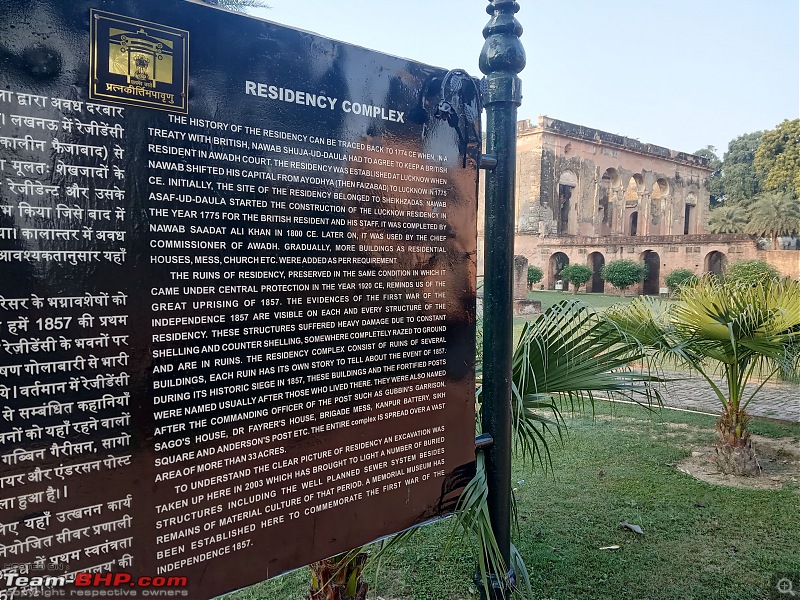
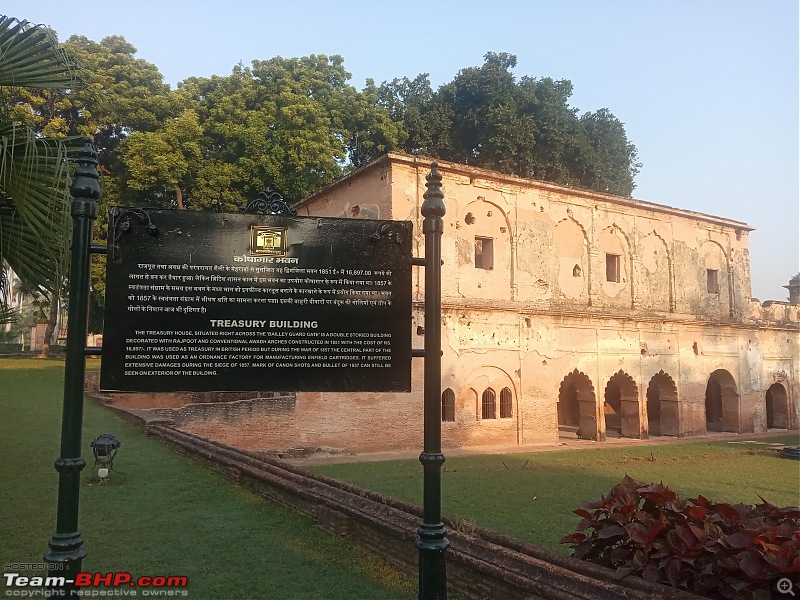
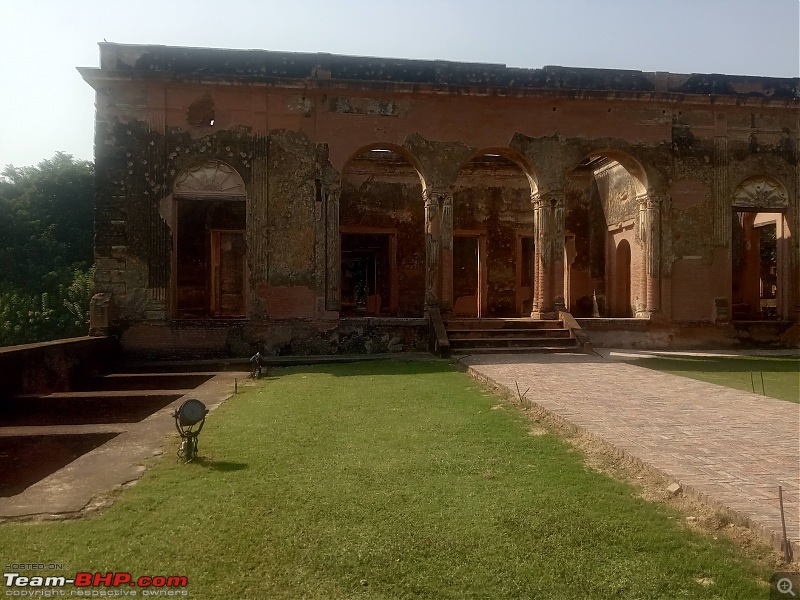
If only these walls could talk
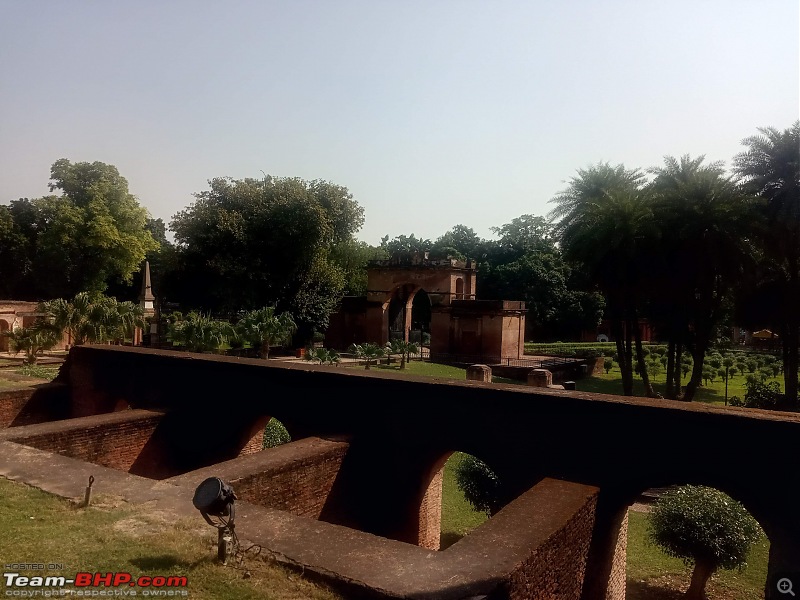
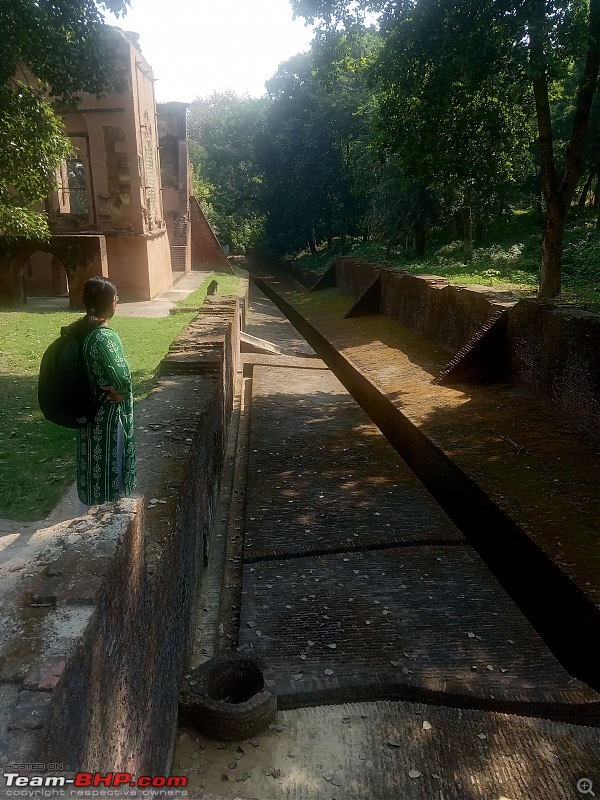
The sewage system
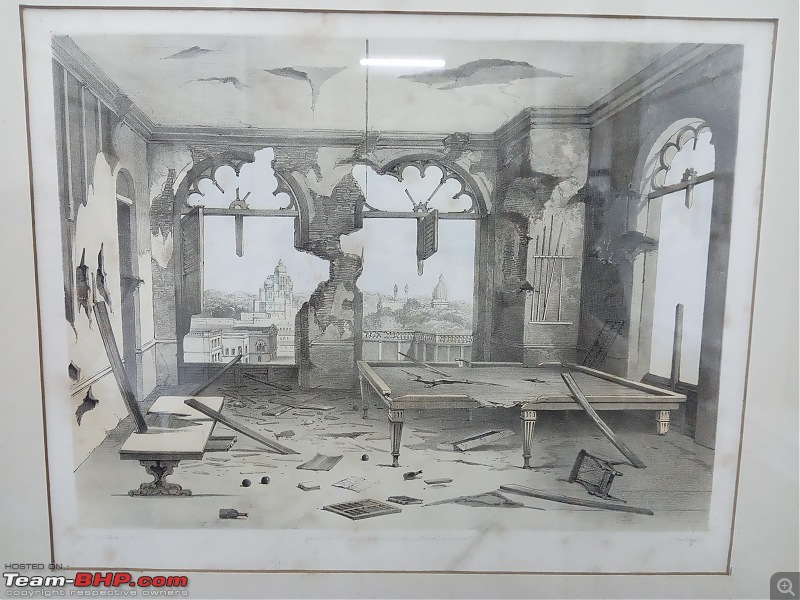
The sketch of the billiards room - an exact depiction of how the place was discovered after the shelling
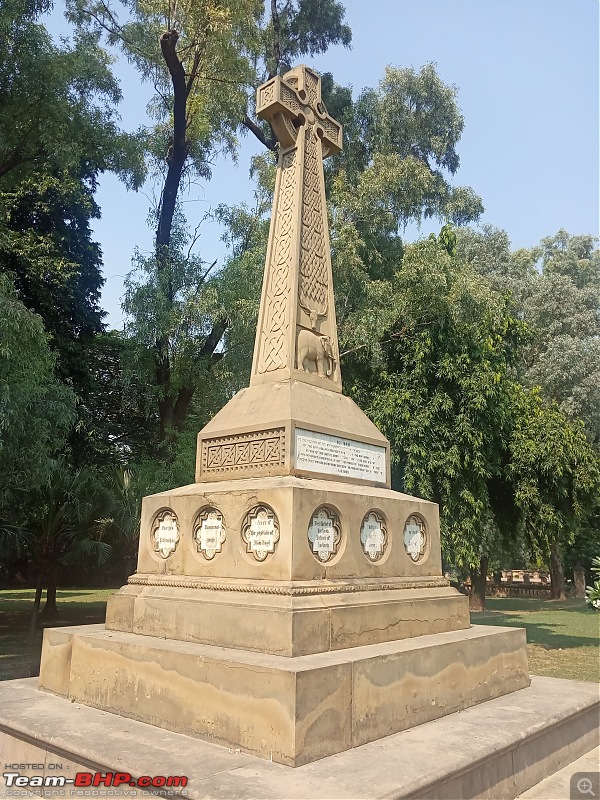
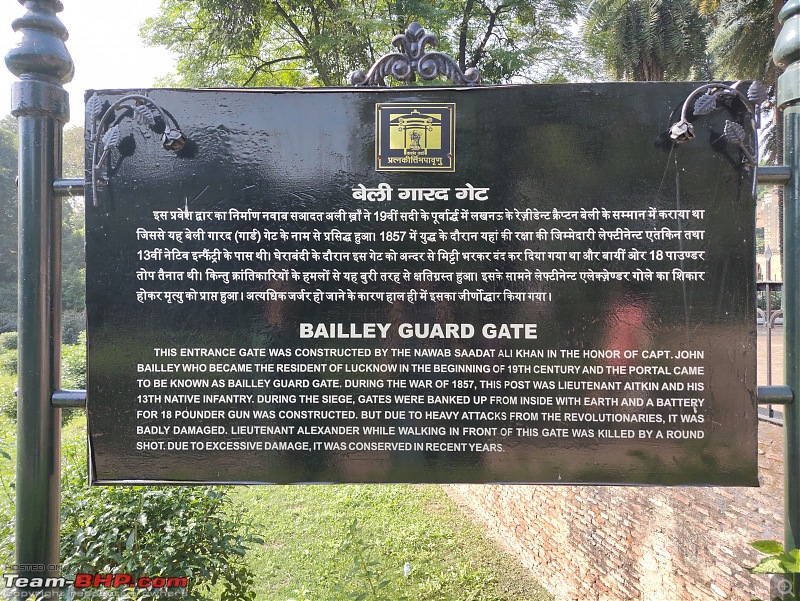
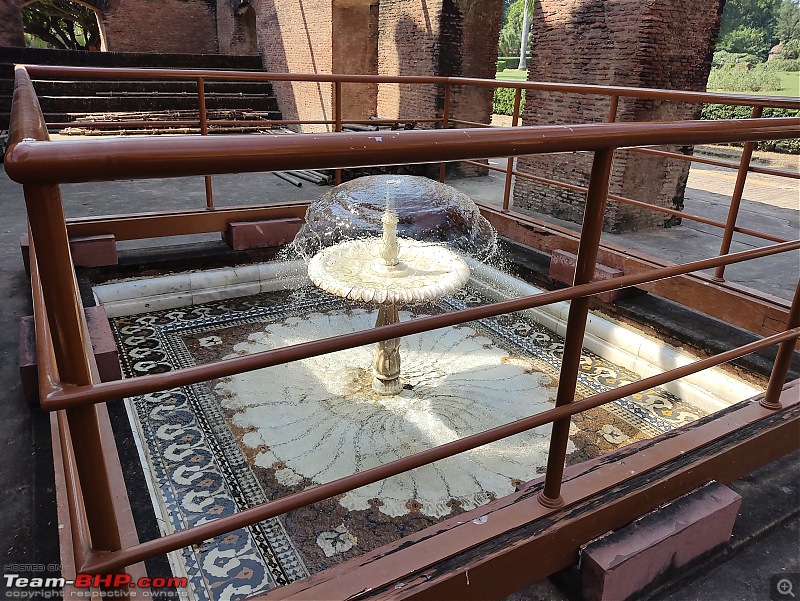
This fountain formed a part of a lavish banquet room
The Bara Imambara - Hide and Seek for the Ranis?
On the drive to the iconic Bara Imambara, my mom tells me that there is a maze on the topmost part of the congregation hall. My dad chimes in to say that in his younger days, that maze was the very place where young ranis played hide and seek! This got me itching to see and check out this fascinating story for myself.
But first I nourished myself with a hearty mug of thick sugarcane juice. Then we went through huge gates and a crowded pavilion to reach the congregation hall. As we know, there are two major parts of Islam - Sunni and Shia Islam. This is a Shia Muslim mosque. Built by Asaf-ud-Daula in 1784, this imposing structure had a markedly different look from the Sunni mosques that I have seen so far. Instead of the delicate domes this building had a detailed fort like structures. Minars and motifs tied this to Sunni architecture. It reminded me of the Hava Mahal in Jaipur, with its several arches and windows. Interestingly, framed portraits of the Iranian leader Ayatollah Khomeini adorned the walls of the ground floor level of the mosque.
Entrusting my loyal Bata shoes to a group of footwear keepers with extreme hairstyles, we started for the stairs leading up to the Bhoolbhulaiya, a word for maze in Hindi. A few guides affectionately warned us that you could not go up the maze without a guide, and we, with equal affection, ignored them. Then came the staircase. It might have looked old, but I could not make out with all the brightly clothed bodies jostling everywhere. I know that many of you out there will understand me when I say that I am allergic to the sound of a baby crying. The symptoms hit my mood the hardest and I tend to become irritable and unsympathetic. And here you may picture the situation if you have peanut allergy and just had ten bars of Snickers! Also, I forgot to mention that people love painting in this particular place. They have come up with ingenious idea of using their mouth! the walls were covered with the monochromatic red artworks, by the paan chewers.
The bhoolbhulaiya was a fun place. There were many mysterious dark staircases, and passages. But the problem was that they had closed off many of the little windows leading deeper into the building, making it impossible to be puzzled about where you were. Every way you went, you could reach an open terrace without warning. Moreover, nothing about it looked old now - the walls were freshly painted and looked commonplace. Nonetheless, I had a nice time.
The mosque inside was painted a lime green, and inside were the four pillars, a concept in Shia Islam. They were gilded houses, or silver ones, an even some brightly colored structures fitting into the niches of the mosque. They resembled colorful raths in Rath Yatra. A peaceful place!
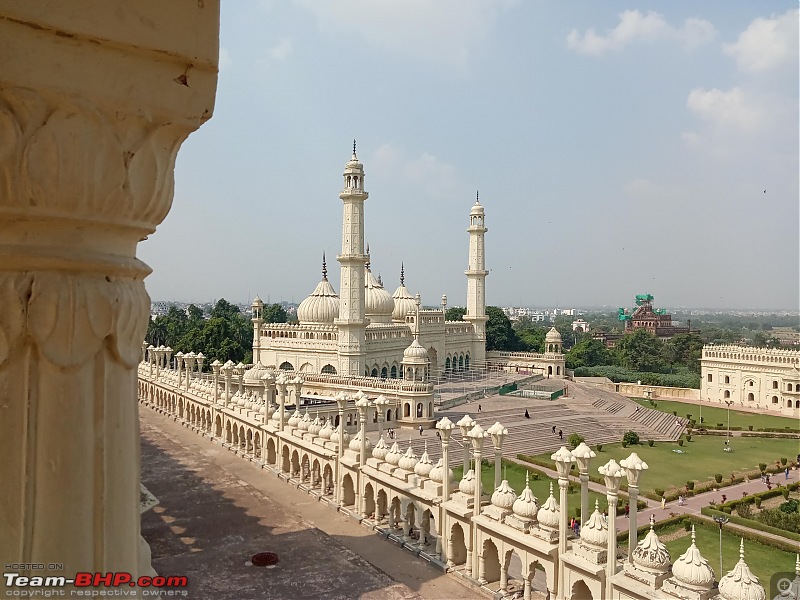
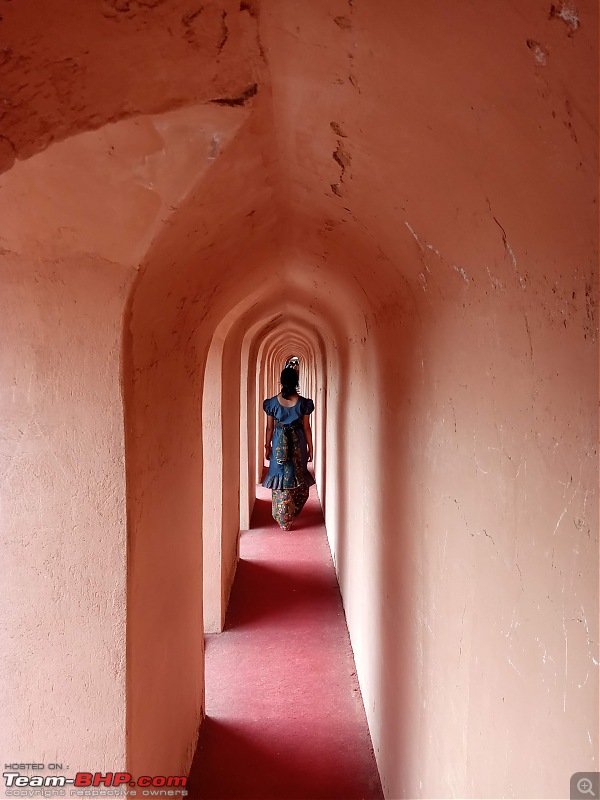
Maze anyone?
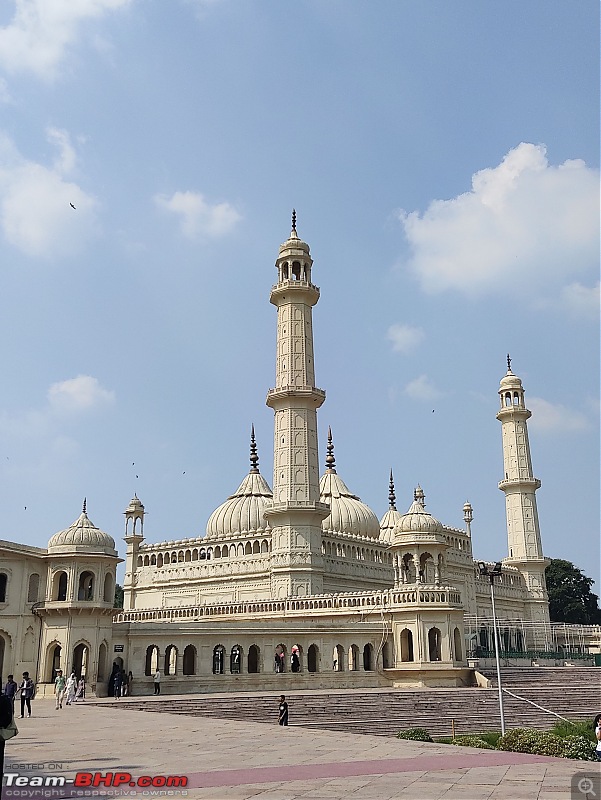
The mosque
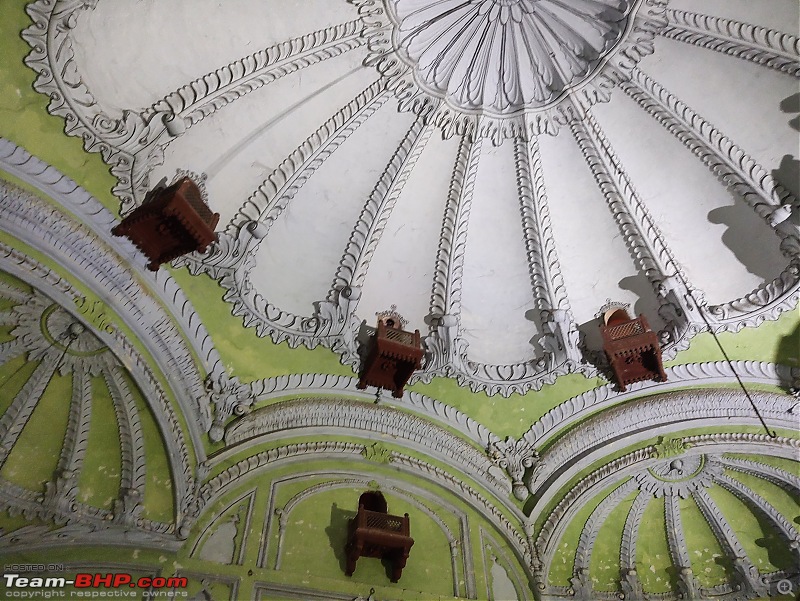
The viewing gallery inside the imambada
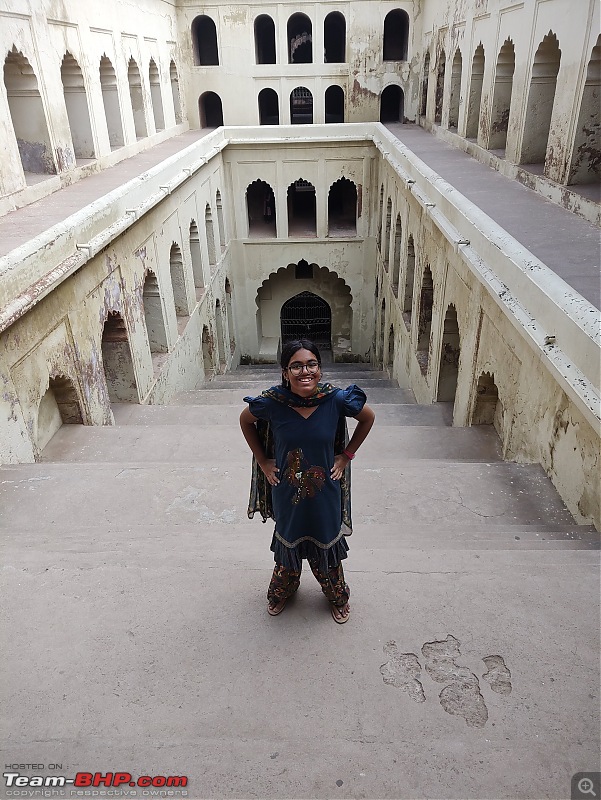
The baoli or stepwell

The imambada entrance at dusk
Chilling at the Chowk
At one of those very common roundabouts we asked a man relaxing by the roadside the way to the famous Tunday Kabab restaurant. He made some very enthusiastic gestures with his arm pointing to the chowk, giving a nice and specific location. It is normal to go out of your way to help strangers in India! Anyways, then he calmed down and said to my dad in a low voice - ''aap kya bada khathe ho?'' or "do you eat beef?'' It was very funny! Then I had my first visit to the chowk.
The chowk is one of those places which have a little bit of everything in them, just like India. You find all kinds of people, from artists to businessmen, all kinds of cultures, from English style clocks to miniature temples. And this chowk in Lucknow boasted of a very special kind of art - Chikan Kari. I remembered Gariahat in Kolkata and the many times I had been there. Lucknow chowk gave Gariahat very tough competition in the sheer variety of things available. My mother was fully contented in looking at the hundreds of things each shop offered. One sold Ittar or perfume in exotic potion bottles and the other sold hookahs made with beautiful, tinted glass. A shop sold an array of clocks and watches while another sold utensils and spare parts. Jewlery, clothes, makeup, car parts, books, crockery, dry fruits - name it and it's available in the chowk. All this lining a narrow dirt road bustling with people and two wheelers.
My mother had the perfect shopping strategy. Instead of buying everything from one place, we went from one shop to the other, checking prices and items. Everything was so pocket friendly! The businessmen were masters of their art. They spoke to you as if you were their dearest friend! People like them know how to treat you. My mother treated herself to a pair of kolapuris and I got a nice salwar kameez suit! While my dad chatted with some shopkeepers, mum and I admired the dresses, kurtas, cloaks, and much more, all adorned with the most beautiful embroidery I have ever seen and at very affordable prices. What a place!
And finally, we reached the legendary Tunday kebabi restaurant. Interestingly, tunday means a one-armed man. Rumor has it that a Mughal noble had all his teeth come out, but he still wanted to enjoy his kebabs. So this restaurant made such soft and melt-in-the-mouth kebabs that you didn't even have to chew them! And if there is any truth in this, the kebabs were the most melt-in-the-mouth stuff I have ever tasted. The restaurant did not look fancy, it was just like one of those kebab eateries in the rest of Lucknow. People kneading, slapping an frying meat with expert hands. And expert they were! We sat down in one of those plastic chairs and told the waiter to give us some chicken biryani, kebabs and parathas. Believe it or not, each serving of kebab cost no more than a tumbler of sugarcane juice - twenty rupees! Trust me, I don't like red meat. But today it felt like the best meat in the world. The balance of the marinade was so beautiful, the smoky flavor just artistic, the texture so creamy.... I closed my eyes and gobbled two plates of kebabs, four pieces each, with truly soft and fluffy Rumali rotis. Picking a kabab up, the whole thing would disintegrate. Imagine! And the chicken Biryani was out of this world. Such subtle taste! The food had such character. The flimsy red plates added to its charm. With a contented pat on my tummy, I walked out of the restaurant with new life.
Next on the menu was some cloud like sweet. With that, we made our way back to the hotel, dropped off our shopping and made for Hazarat Gunj. A true High Street, it had high end boutiques and shops. The buildings were all old, but the shops modern and glitzy. I could spend an evening just sitting at one of the benches in the sidewalk and hang out. Gunjing, as my Grandad called it.
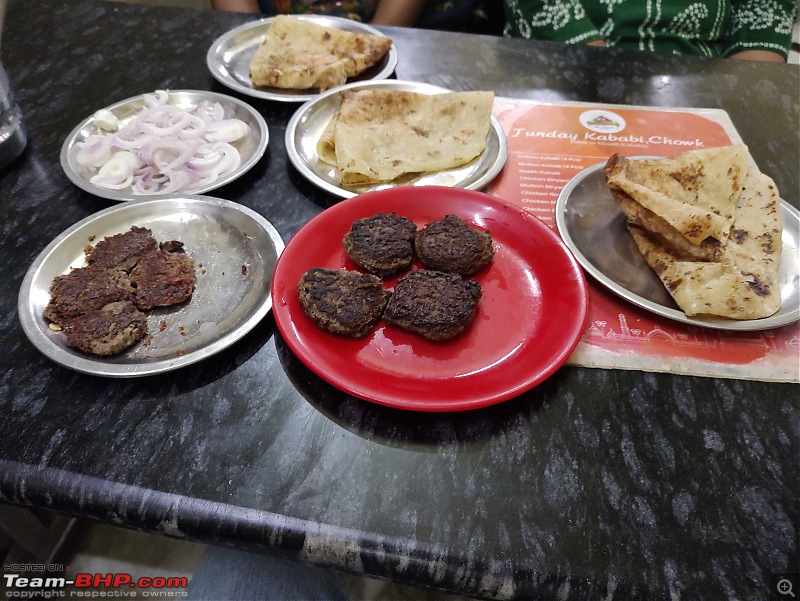
delicious!
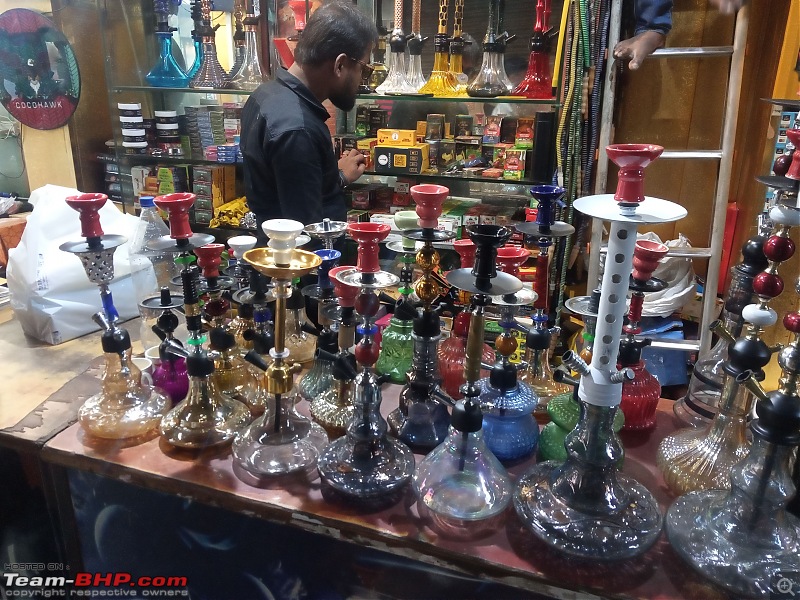
Arabian nights at Chowk

The Gunj is buzzing
Day 15, a visit to the zoo, the Chota Imambara - and the end of our trip
Next day when I woke up, my dad was, yet again, revving to get started. Here I was, yawning and rubbing the sleep off my eyes, and he, checking his watch and looking as if half a day had passed. My dad, on trips, goes on overdrive.
We went to have breakfast at a cute little sweet shop at a place called Nishadgunj, where my dad remembered eating fried dough and creamy lassi a few decades back. A sweet faced man, the owner, showed us to a little table and brought us two lassis, samosas, and jalebis. The jalebis were accompanied with some fresh and thick dahi and you were supposed to dunk the twisty sweets in them before plopping them in your mouth! These, my friend, were the definition of heaven. One sip from the lassi tickled my ears and made my heart feel like it would overflow. Pure happiness is what it is - that glass of lassi. Don't get me started on the jalebis. Dripping spirals of sunshine and sugar! The samosas were so good that I could eat five of them. A man was sitting in front of us, wearing running shoes - he probably came here everyday to have breakfast and to put back the little calories he lost on his daily walks. On our way out, Mr. Sweet face gave me a white cube of a mithai to taste. It's one of those rare things which make you instinctively close your eyes and go mmmmm... My dad liked the lassi so much that he brought the terracotta lassi tumbler back home. ''I'll use it to drink water'' was his explanation.
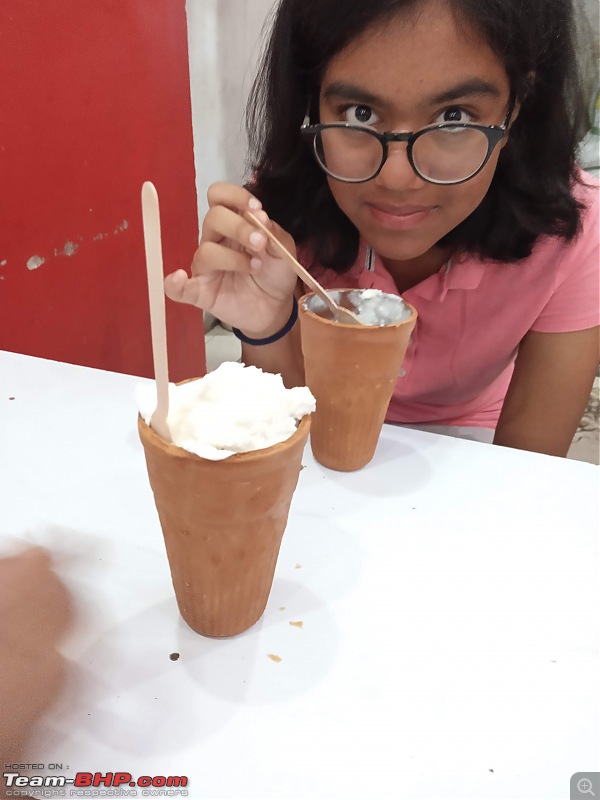
The legendary lassi
Our next stop was the Lucknow zoo, mainly because the musuem was located inside which we wanted to visit. It was like most other zoos - with glass cabins of shockingly large snakes and small enclosures of tame tigers looking completely at ease with thirty people clicking pictures at it every second. It was a big zoo, so we didn't see the whole of it. The museum had many old models of queen Victoria and the King along with a few other nobles, made of marble and iron. There were a lot of exhibits, from art and craft to medieval weaponry. There was even an Egyptian gallery believe it or not! Fancy meeting mummified Pharaohs in the heart of Awadh. The museum is worth a visit but many exhibits were closed because of some work.
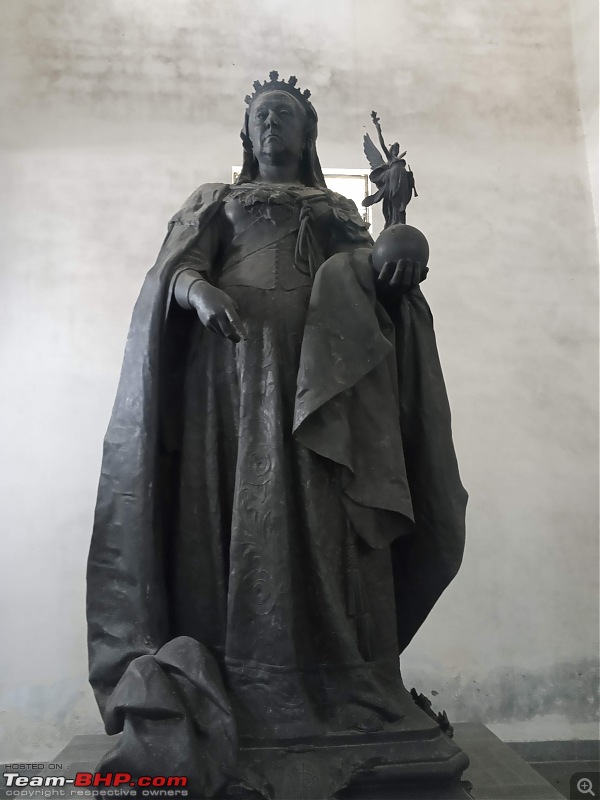
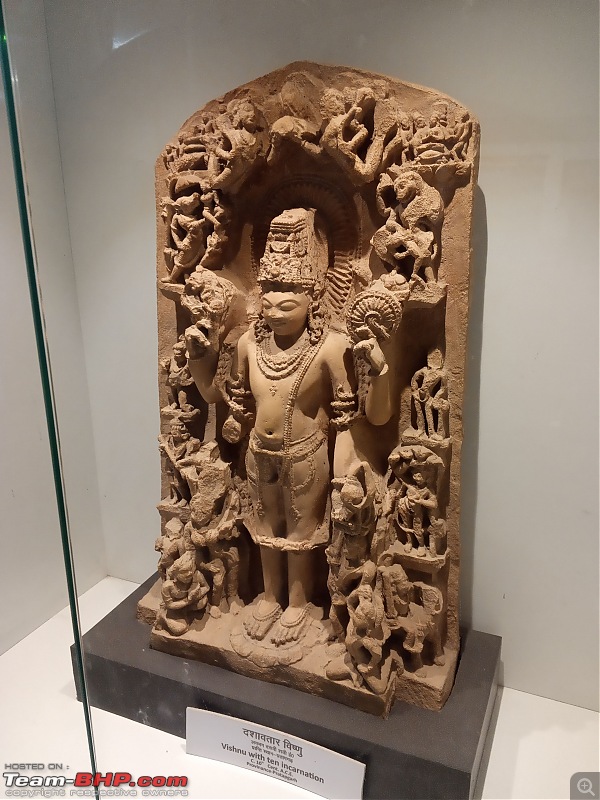
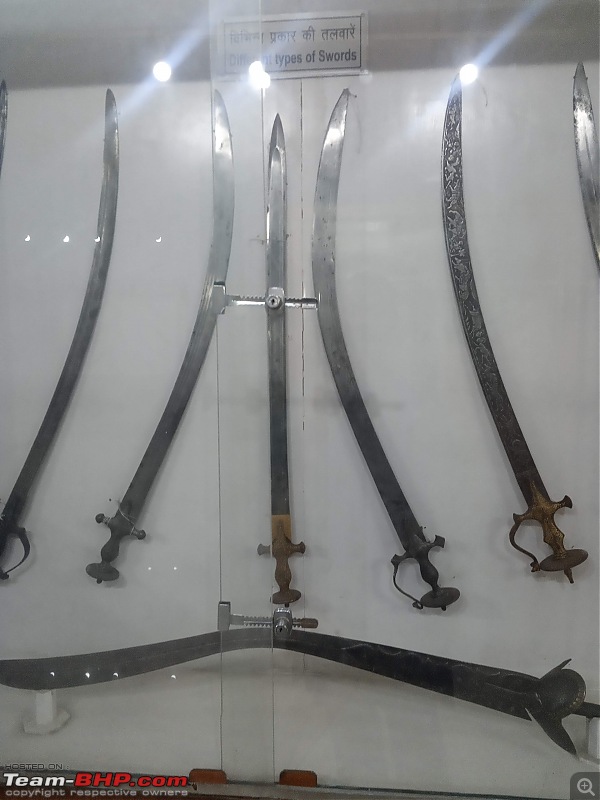
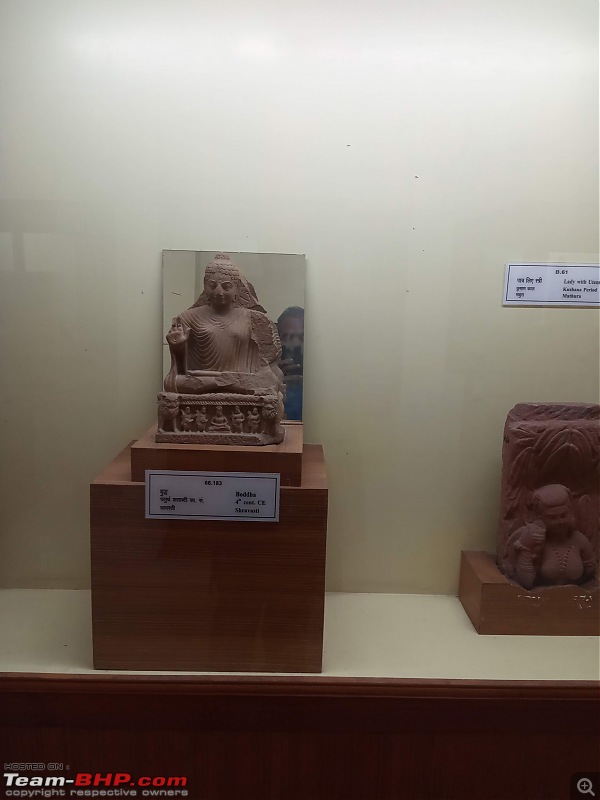
Next on our list came the Chota Imambara. It was a small, whitewashed building, but it looked a bit older than its bigger compatriot. The inside was filled with shimmering chandeliers and diamond fountains. On display were exquisite, tinted glass chandeliers and gemstone stands. It had a medieval look to it, though.
This time for lunch we were going to the Aminabad Tundey restaurant. It was a more cheerful, better decorated place. The food was just as fantastic. The entrance walls had pictures of big celebrities who came here and the owner. After lunch We chilled at the Ghantaghar for a while and Gunjed for a bit more and then went back to our hotel. It dawned upon me that our long trip was nearing to an end...
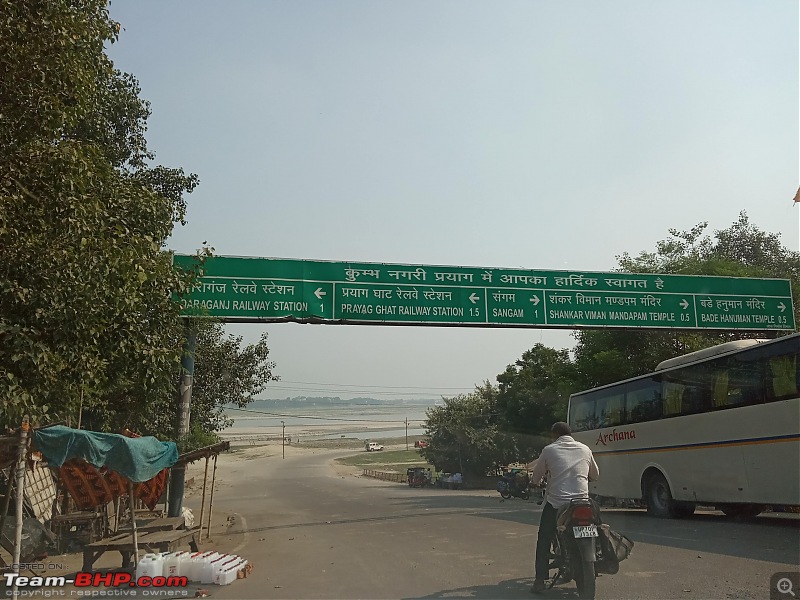
from Lucknow to Jabalpur via Prayagraj
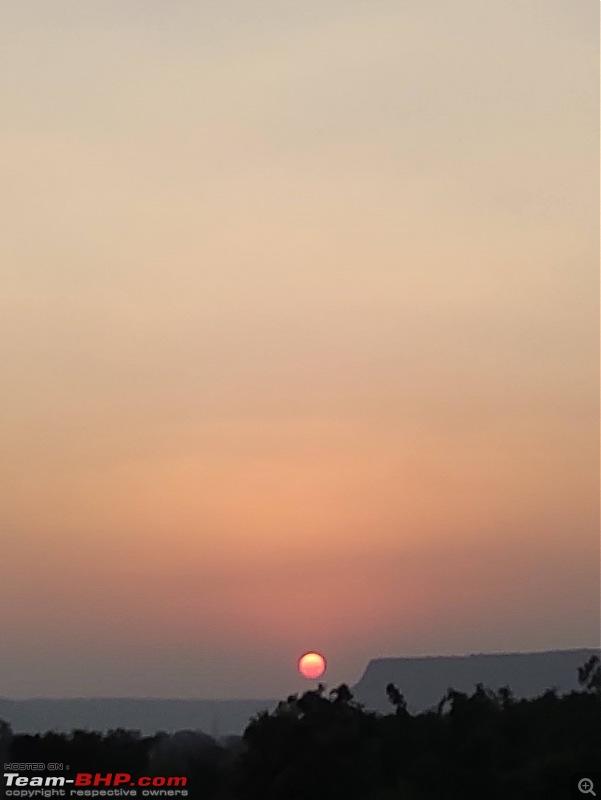
A sunset on the way
So, dear reader. This is it. Our trip ended and with that, this article. We drove back through Jabalpur and came back to Hyderabad. Although home seemed like a wonderful place to be, I felt a little depressed of the fact that there were no other places to look forward to. This was our longest trip, 16 days in total, 5,283 kilometers, and the trip where our car passed one lakh kilometers. This is my longest article, but it is for me to congratulate you, my friend, for reading this long and this far! It has been my pleasure to have kept you scrolling till the end. A big thanks to my dad for encouraging me and pushing me to keep writing
 ). I learned a lot from writing this, and it would really help me out if you shared your thoughts and some pointers. It would help me improve my writing. Also please share your experiences here. It would be delightful to read them.
). I learned a lot from writing this, and it would really help me out if you shared your thoughts and some pointers. It would help me improve my writing. Also please share your experiences here. It would be delightful to read them.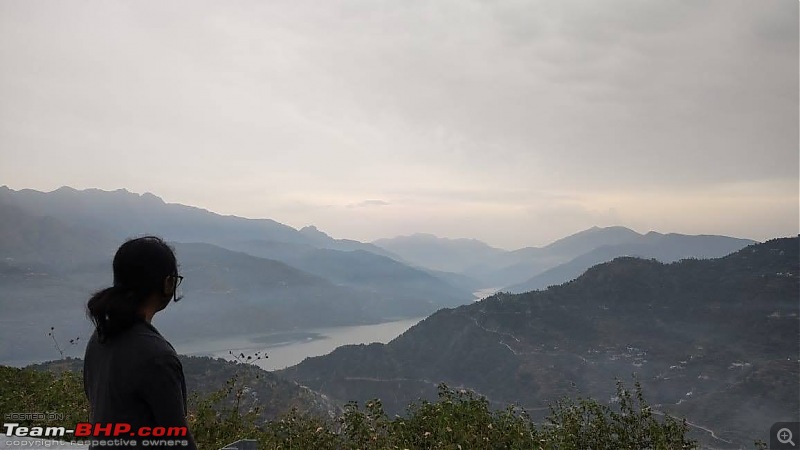
There's something for everyone in India!
